Quick and Easy Homemade Sous Vide Vanilla Extract
This post delves into making homemade vanilla extract using Sous Vide cooking. By precisely controlling the temperature and time, sous vide could create a superior flavor extraction from the vanilla beans. We guide you through the step-by-step instructions, emphasizing the importance of using high-quality beans and a suitable alcohol base. With our simplified method, you can achieve gourmet-quality vanilla extract in a fraction of the time and price that is typically required. This unique flavoring agent can elevate your baked goods recipes.
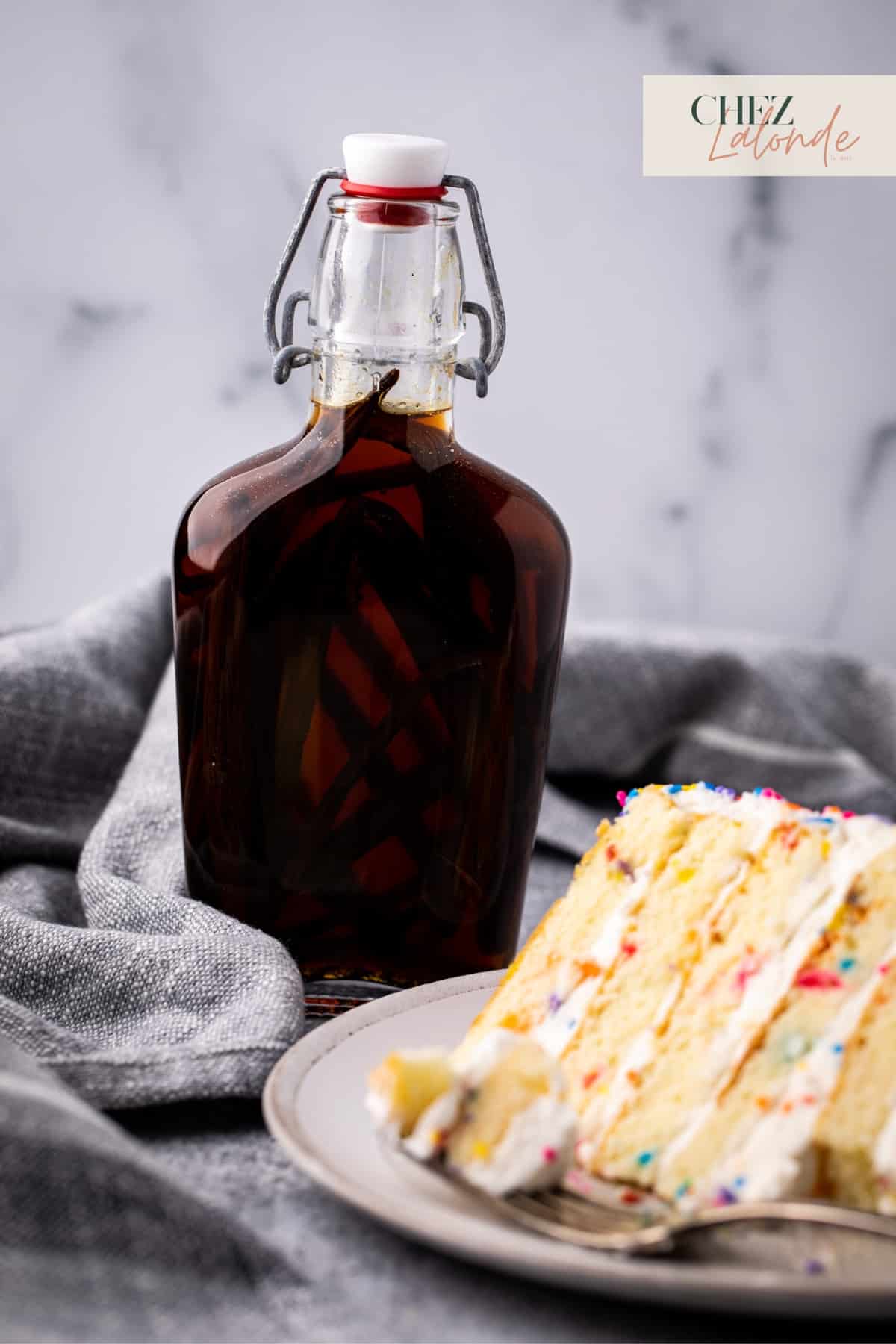
Disclaimer Notice: This website contains affiliate links. If you make a purchase through these links, I may earn a commission at no extra cost to you. I only endorse products or services I believe will be valuable to my readers. I appreciate your support.
Have you watched The Barefoot Contessa show with Ina Garten (Gosh, I love her) on The Food Network? She often mentions “The Good Vanilla” when she bakes. She was referring to a natural vanilla extract from fresh vanilla beans. While pure vanilla extract is pretty pricey, it adds a fragrant and gourmet touch to baked goods. Traditionally, making vanilla extract at home takes a minimum of 12 months. But I have a quicker method to shorten the wait by 9 months. With the holiday season approaching, it’s the perfect time to prepare this gourmet homemade vanilla extract as a meaningful gift for some baking enthusiast friends and family of yours.
Let’s start and learn how to make this gourmet flavoring at home.
Recipe Snapshot
EASE: Easier to make than you might think. All you need are Vodka and Vanilla Beans.
PROS: You can use the finest ingredients, resulting in a superior flavor profile.
CONS: Extended flavor development time is a downside of making vanilla extract.
WOULD I MAKE THIS AGAIN? Absolutely. This made the best housewarming or Christmas gifts.
What is vanilla extract, and what can you do with it?
Vanilla extract is a concentrated liquid flavoring agent derived from vanilla beans. It enhances the taste and aroma of food and gives them a rich and aromatic quality. It is commonly used in baking to add vanilla’s distinct and delightful flavor to various recipes such as crème brûlée, Hong Kong bubble waffles, cookies, cakes, custards, and ice creams.

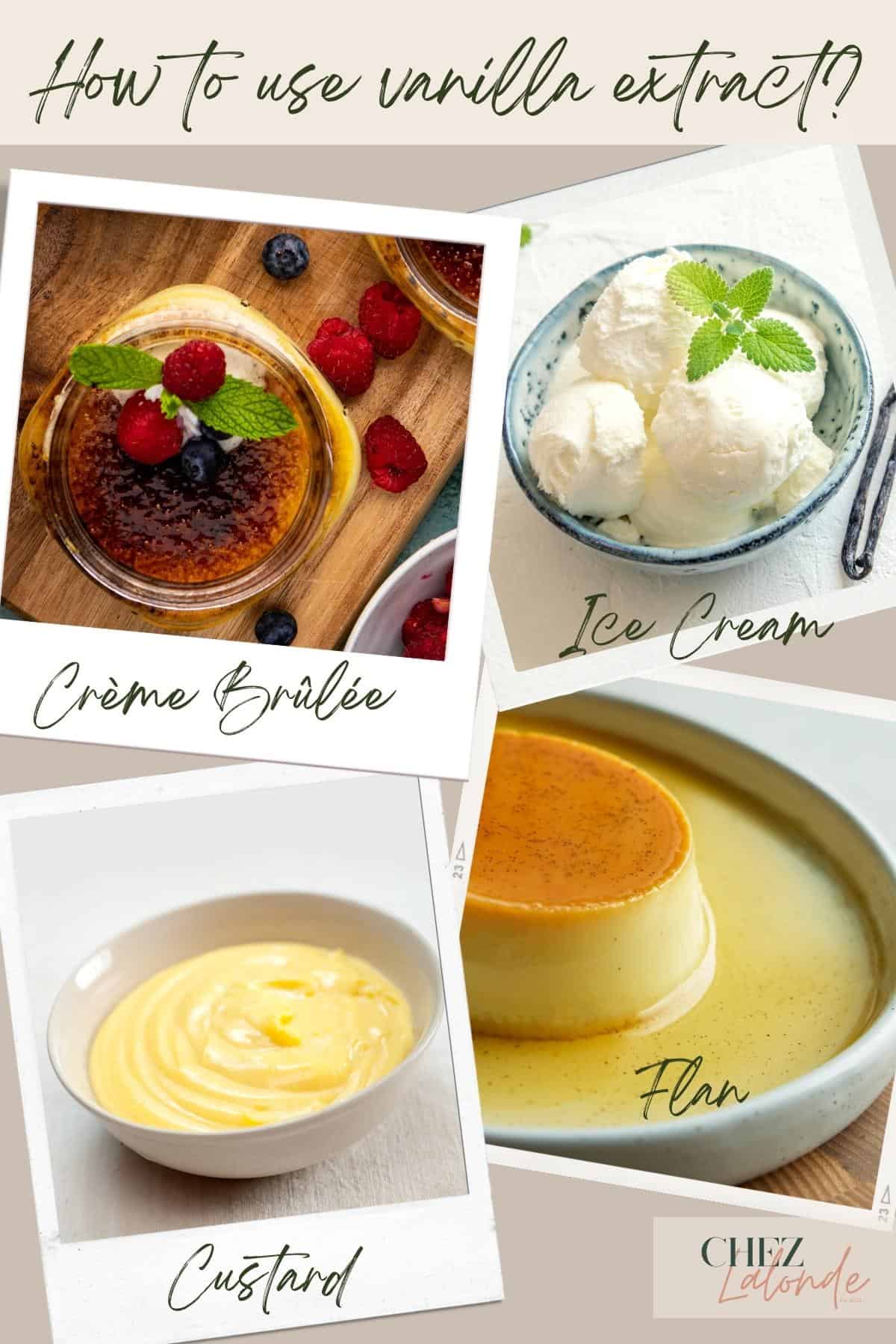
What is the difference between vanilla extract and vanilla essence?
You often hear these two terms used interchangeably in the baking world. However, they are two distinctively different flavoring agents. Let me elaborate:
Vanilla Extract:
It is more expensive and is generally preferred among baking enthusiasts due to its authentic flavor and natural origin. It is widely used in baking, cooking, and various recipes.

- Ingredients: It is made with real vanilla beans steeped in alcohol to extract the flavors and aromas for an extended period, traditionally for 12 months.
- Flavor Profile: Derived from natural vanilla beans, it offers a complex and authentic flavor profile with nuances and depth.
- Strength: It tends to have a stronger and more pronounced flavor. Since it is made with real vanilla beans, it contains many aromatic compounds.
- Regulations: In the United States, vanilla extract must be made from vanilla beans and meet specific standards set by the FDA.
Vanilla Essence:
It is a synthetic flavoring. Usually used by commercially produced products as a more affordable alternative.
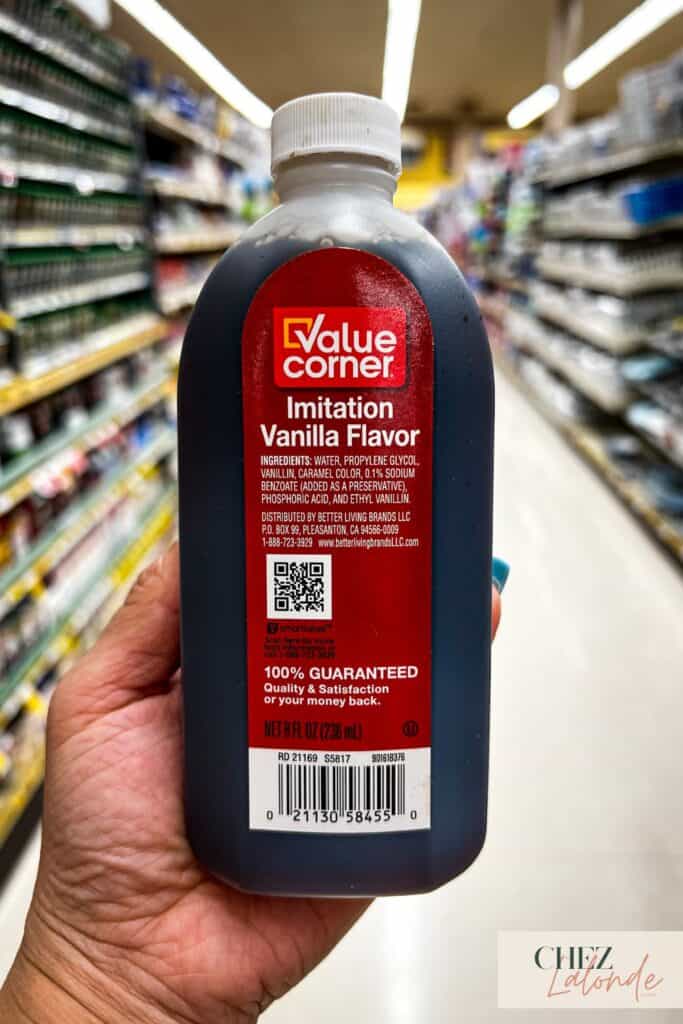
- Ingredients: It is an artificial flavoring that mimics the taste of natural vanilla. It is made from vanillin, ethylvanillin, and other synthetic compounds. It costs way less than natural vanilla extract.
- Flavor Profile: Although it has a vanilla taste, it lacks the complexity and depth of natural vanilla.
- Strength: It has a concentrated synthetic vanilla flavor.
- Regulations: FDA requires manufacturers to be clear on their labeling to show that it is synthetic flavorings and does not come from natural vanilla beans.

Why should you make your vanilla extract using Sous Vide at home?
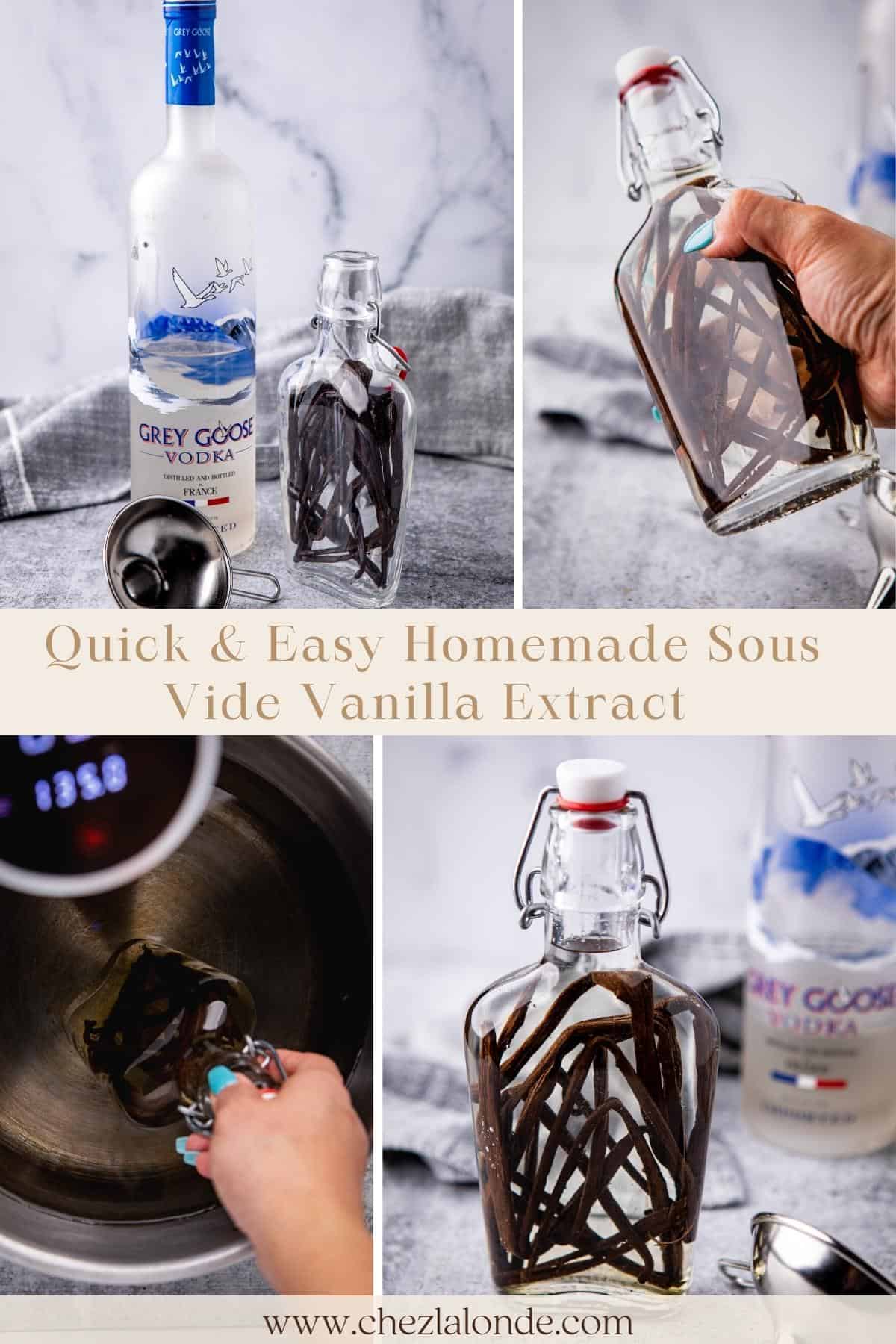
Cost saving:
Do you know that an 8 oz Nielsen-Massey Madagascar Bourbon Vanilla Extract is retailed for nearly $50 US a bottle? (WOW) By making your own using premium vanilla beans and vodka, you can create a large batch of gourmet extract at home for a fraction of the cost. With a pound of fresh Madagascar vanilla beans and 1.75 Liter of Tito’s vodka, you can produce seven to eight 8 oz bottles of homemade extract for around $16 US or less. That’s nearly less than half the price of store-bought options, saving you money without compromising quality.
Ensuring the highest quality:
Creating your vanilla extract allows you to handpick premium quality ingredients, from the choice of liquor to the grade and origin of the vanilla beans. You have complete control over the sourcing process, ensuring that only the finest ingredients are used to craft your personalized extract to meet your needs.
Time efficiency:
No more waiting for a year to infuse your vanilla extract! With the Sous Vide method. This technique cuts your infusion time by more than half, and you can have high-quality vanilla extract ready in a fraction of the time. This means you can quickly dive into baking and enjoy the flavors of homemade treats sooner. You can quickly scale up your production to make multiple bottles for personal use or as thoughtful gifts for friends and family.
What is Sous Vide precision cooking?
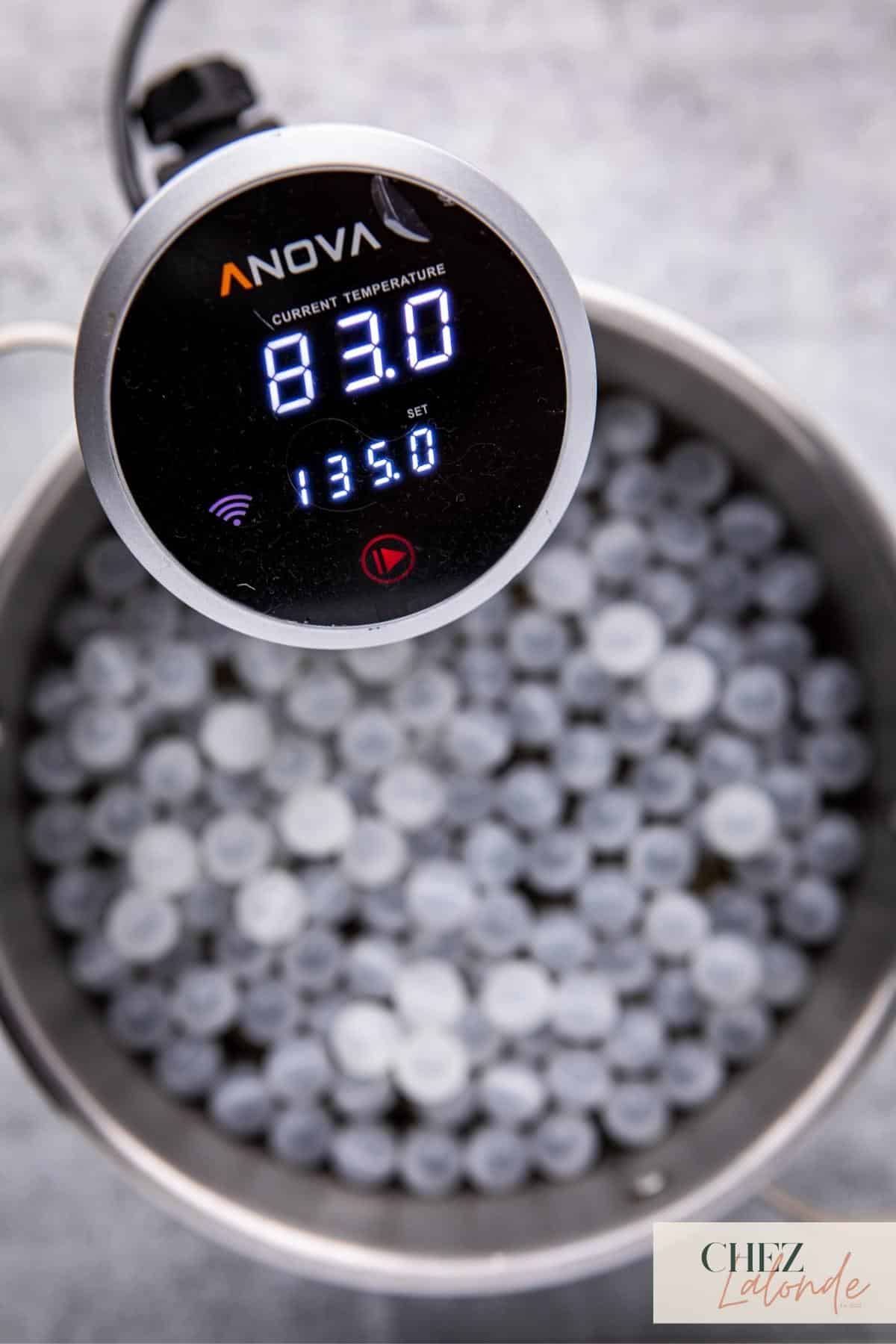
Sous vide precision cooking is an exquisite culinary method originating in France. It involves precisely cooking food in a water bath using an immersion circulator and maintaining a consistent temperature for an extended duration. This technique is the best choice because that offers the easiest way and boundless possibilities, enabling the preparation of tough cuts of meat, cooking delicate desserts such as crème brûlée, egg pasteurization for food safety, and various other culinary applications. Sous vide has gained immense popularity among home cooks, and to delve deeper into this remarkable cooking technique, feel free to explore my Sous Vide Filet Mignon post.”
What is the difference between Sous Vide and the traditional infusion process?
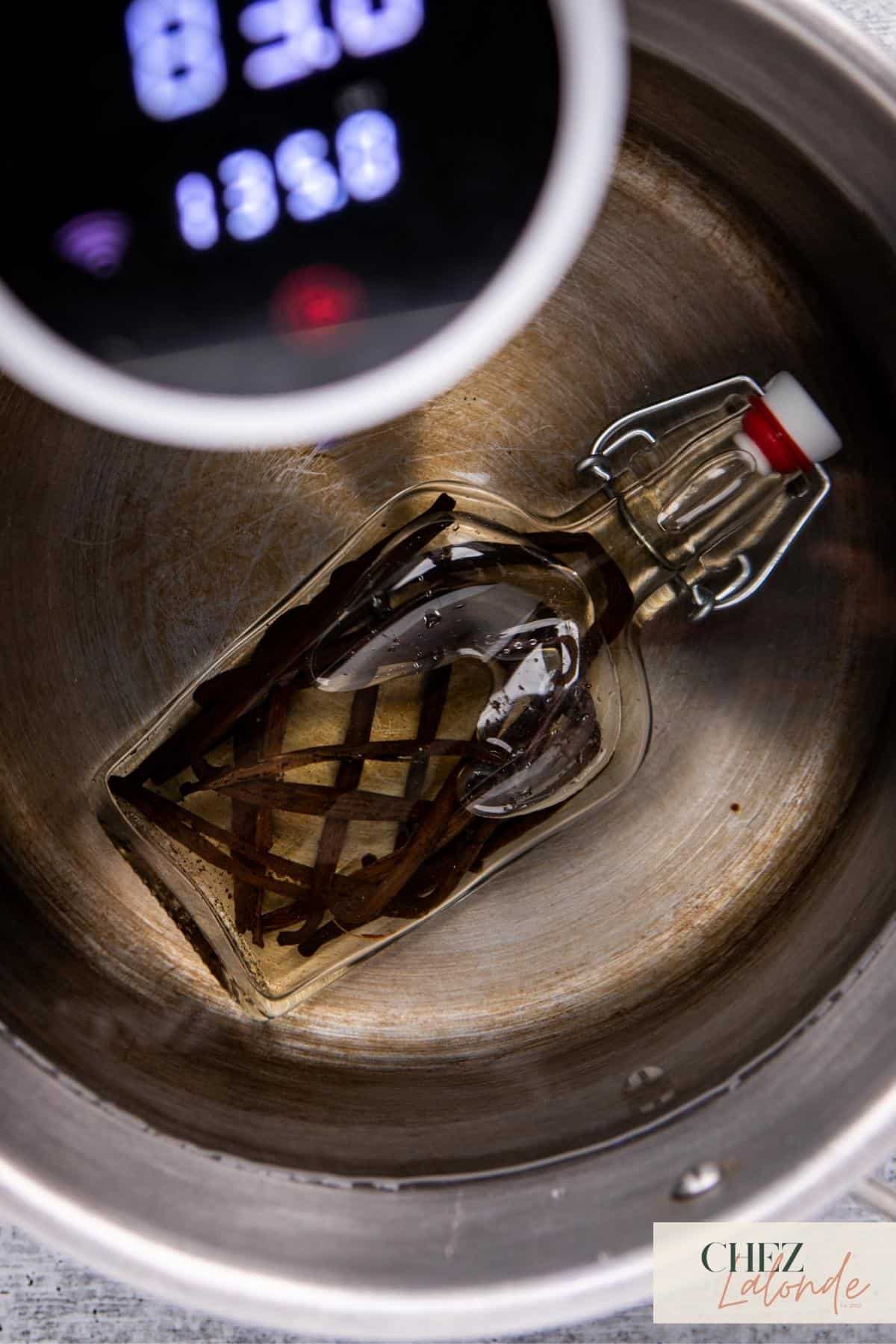
Sous Vide Method:
The Sous Vide method guarantees the highest quality vanilla extract with precise temperature control for consistent results. By heating the vanilla extract in a controlled environment, it accelerates the extraction process without compromising the delicate flavor compounds of the beans. The result is a superior extract with a robust and authentic vanilla flavor profile akin to steeping a tea bag in hot water.
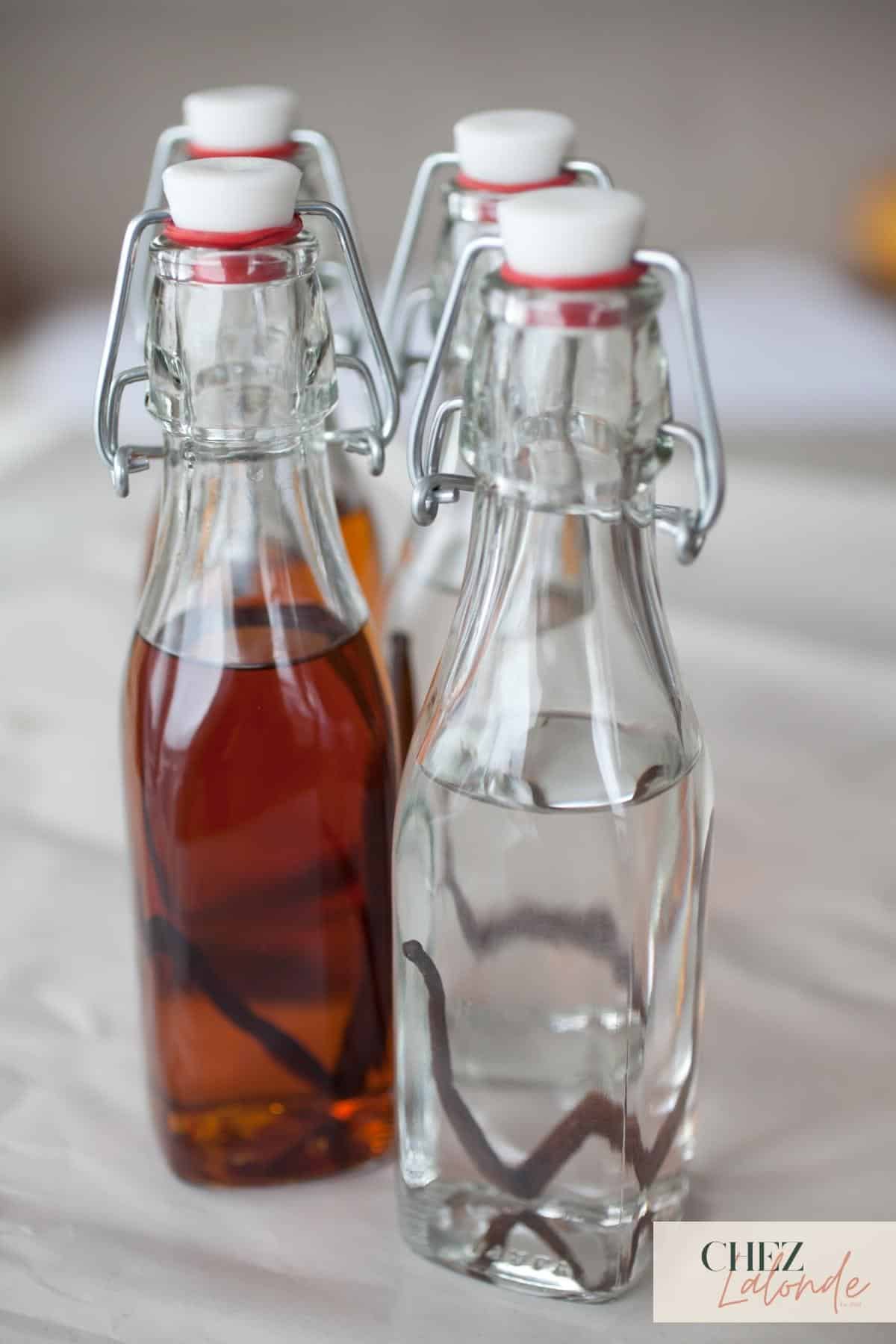
Traditional Method:
Traditionally, begin by splitting the vanilla beans lengthwise and placing them in a glass jar. Submerge the beans in high-proof alcohol, like vodka. Store the bottle or jar in a dark place, such as a cupboard, and allow the beans to infuse the alcohol for 12 months. Though a lengthy process, this traditional method yields a delightful vanilla extract.
How do I know when my vanilla extract is ready to use?
To determine if your vanilla extract is ready to use, you can follow these indicators:

- Time: The recommended minimum time for Sou Vide method extraction is around 3 months. After this period, the flavor of the vanilla beans should have been infused into the alcohol.
- Color: The extract should have a rich, dark amber color. This indicates that the vanilla beans have released their flavor and fully infused extract.
- Aroma: When you open the bottle, you should be greeted with a strong and fragrant vanilla scent. The smell should be pronounced and enticing.
- Taste: Dip a quarter teaspoon of vanilla extract into a small glass of milk (preferably a shot glass) and taste it. It should have a robust and distinct vanilla flavor. The taste should be smooth and free from any harsh or bitter notes.
How soon can you use your sous vide vanilla extract?
You can start using your sous vide vanilla extract as soon as the extraction process is complete and it has cooled to room temperature. However, for optimal flavor, I highly recommended letting the vanilla beans continue to infuse the extract for an additional 3 months. This will further enhance the flavor and depth of the vanilla extract.
Let’s learn about Vanilla Beans!
You can’t make a good vanilla extract at home without some basic vanilla knowledge. So here you go:
Where is vanilla originate, and what is the harvesting process?
Vanilla originates from the pod of a climbing orchid. After hand-pollination, the beans take weeks to mature and are harvested months later. To stop ripening, the beans are immersed in hot water and then dried using various methods. They undergo a slow curing process in the sun for months to reduce moisture to approximately 30%. This intricate process contributes to the higher cost of vanilla.


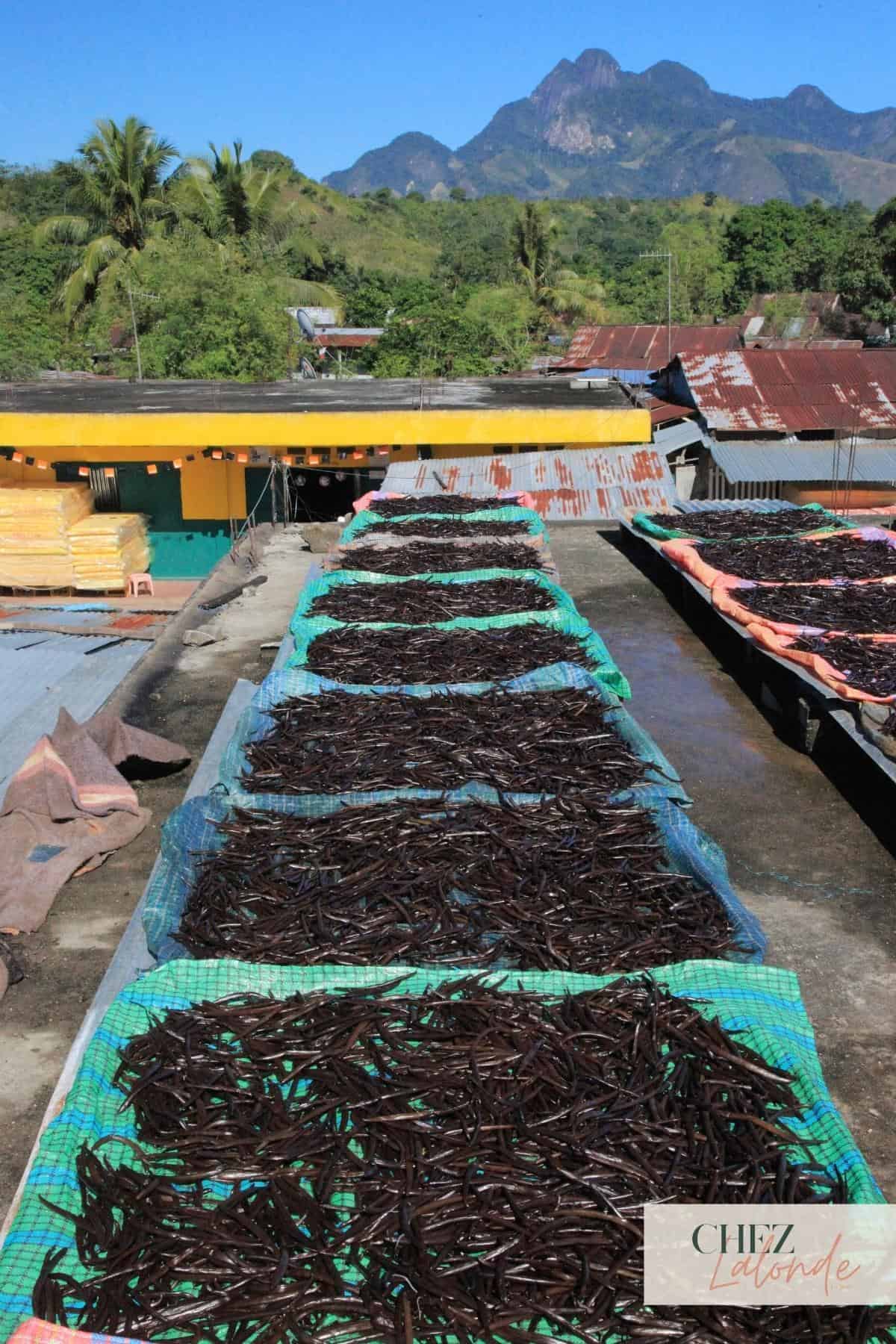
What are the various vanilla bean varieties?
There a many varieties of vanilla beans around the world. Each type of vanilla bean brings its character and flavor nuances to culinary creations, allowing chefs and bakers to explore different taste profiles and create diverse and delightful dishes. Today, let’s focus on three of the most well-known ones.
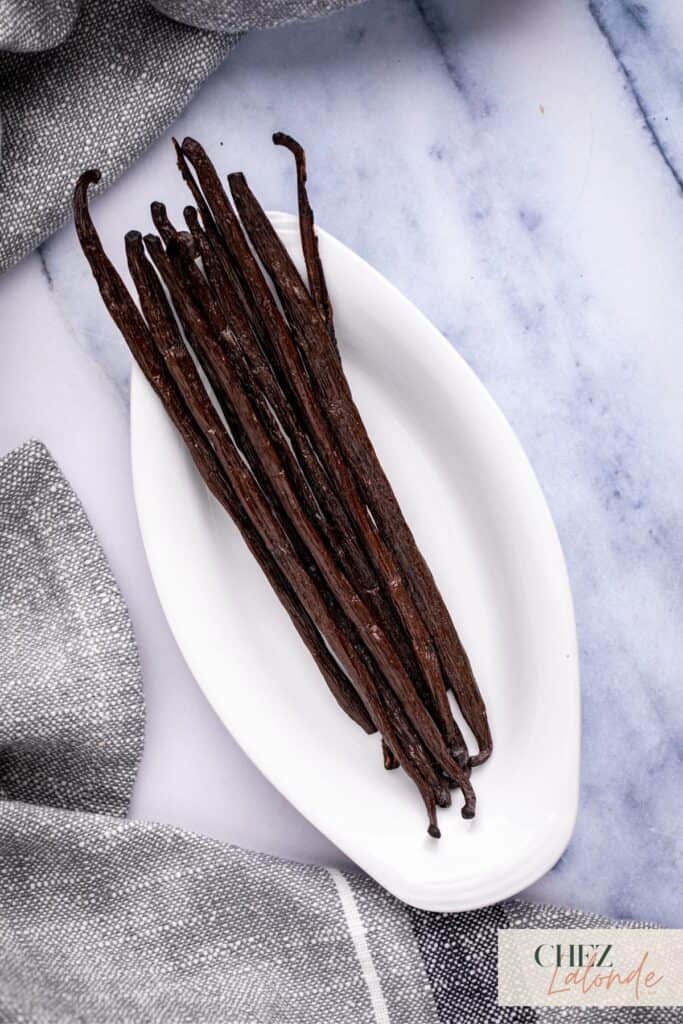
Madagascar Vanilla Beans:
Madagascar, or Bourbon vanilla, is the most common and popular type. It is known for its rich and creamy flavor profile with notes of chocolate and caramel. Madagascar vanilla beans are plump, oily, and have a high vanillin content, contributing to their sweet and robust flavor. They are versatile and widely used in various culinary applications.

Mexican Vanilla Beans:
Mexican vanilla beans have a unique and distinct flavor profile. They are known for their smooth, spicy, and slightly woody taste with hints of cinnamon and nutmeg. Mexican vanilla beans are often considered more delicate and subtle than Madagascar beans. Chefs and bakers highly prize them for their exceptional flavor.
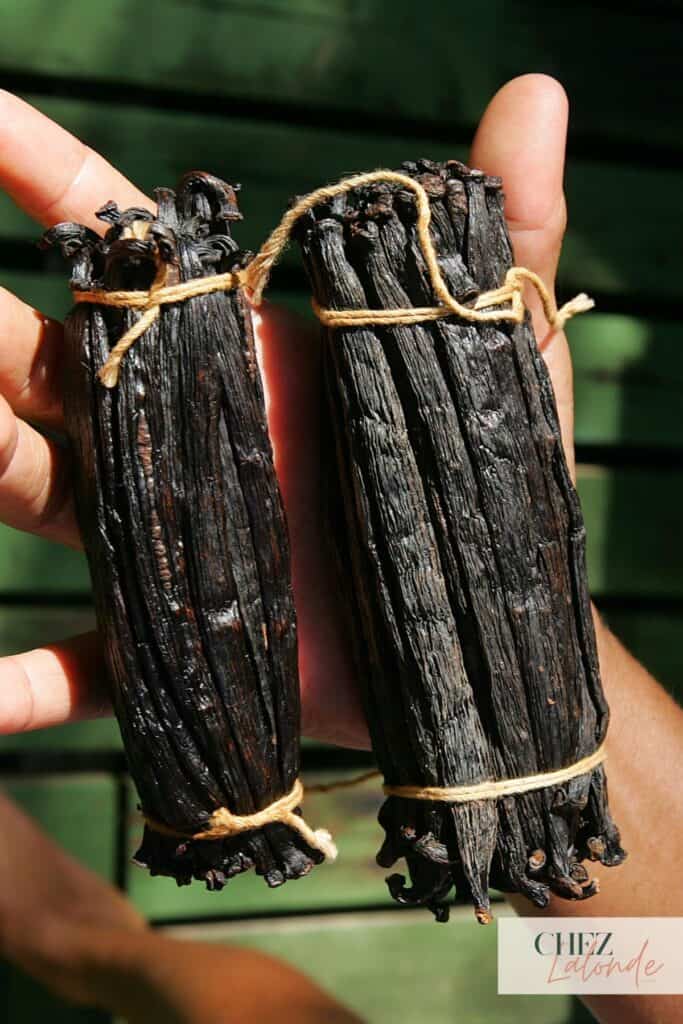
Tahitian Vanilla Beans:
Tahitian vanilla beans are distinctively different from the other types. They have a floral and fruity flavor profile with cherry, licorice, and anise notes. Tahitian vanilla beans are plump and moist, and their aroma is often described as delicate and aromatic. They are particularly well-suited for desserts, custards, and other gourmet recipes where their unique flavor can shine.
What is the difference between Grade A and Grade B vanilla beans?
The difference between Grade A and Grade B vanilla beans lies in their quality, moisture content, and intended use:
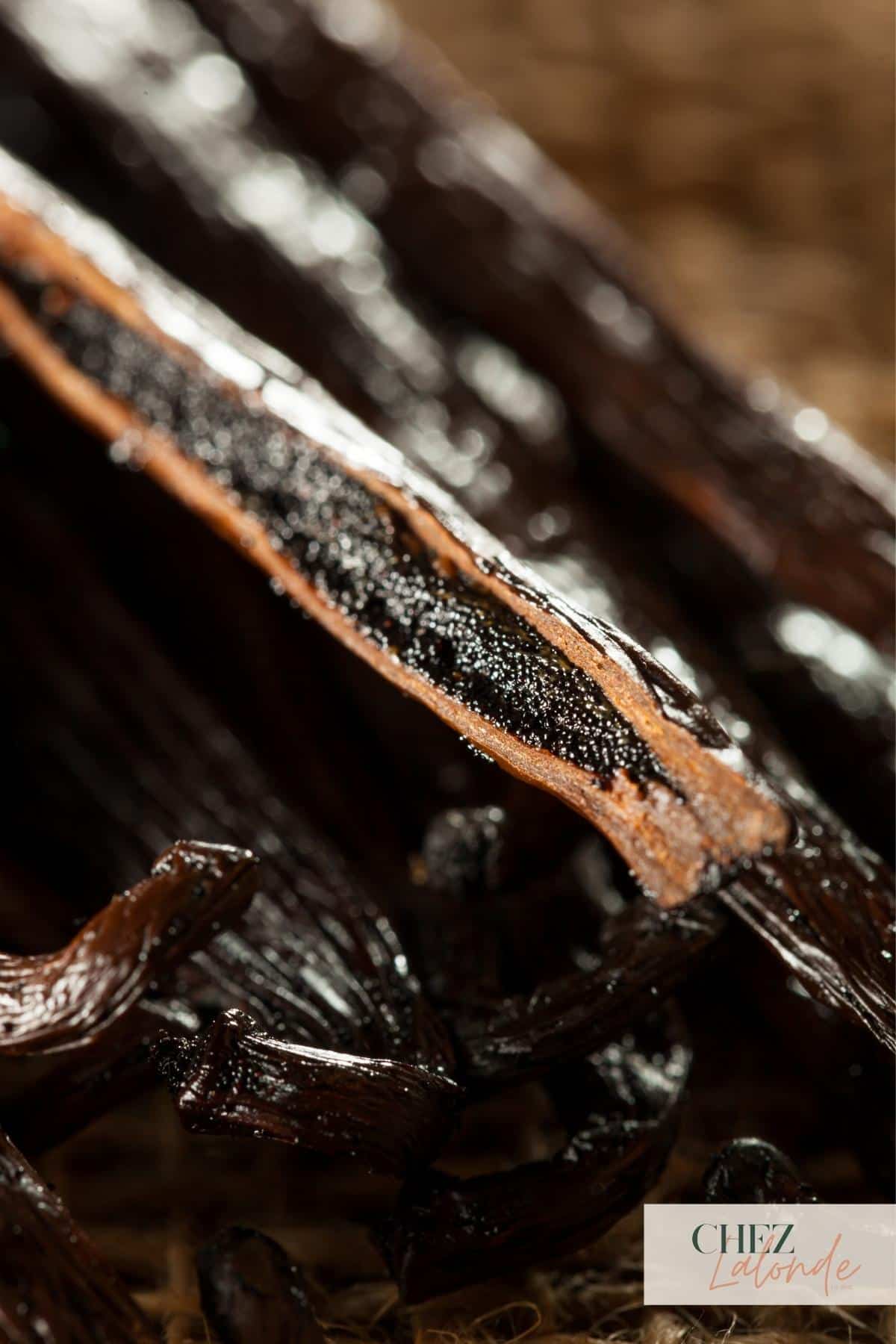
Grade A vanilla bean
- Quality: It is considered with higher quality, visually appealing, plump, and well-formed pods.
- Moisture Content: They have higher moisture content, making them more supple and easier to work with.
- Flavor and aroma: They have a more pronounced and intense flavor. They are famous for their rich and intense vanilla notes.
- Intended Use: People use grade-A vanilla beans directly in their baked goods and desserts due to their intense flavor and component.
Grade B vanilla bean
- Quality: It usually has blemishes and irregularities in appearance.
- Moisture Content: Have lower moisture content and appear drier.
- Flavor and aroma: They have a milder flavor and aroma.
- Intended Use: They are often used for making vanilla-infused products, such as vanilla sugar or vanilla powder, where the visual appearance is less important and a milder flavor is preferred.
Pro Tips:
When purchasing vanilla beans for your extract, I suggest using grade B vanilla beans. They are ideal for infusion purposes and are more cost-effective than other grades.
Where are the best places to find economical and good-quality vanilla beans?
I acquired my vanilla beans during a sale at Costco. If you intend to make a smaller batch, you can find vanilla beans at Costco or your nearby supermarket. However, if you’re planning to create a substantial batch for gifting purposes or personal use, you can explore online options such as Beanilla.com, Amazon.com, vanillapura.com, or slofoodgroup.com. These platforms offer a wide selection of vanilla beans and offer wholesale pricing. Some also have extensive information on their website to educate you further about vanilla.
Two key Ingredients that you need to make this gourmet flavoring agent:
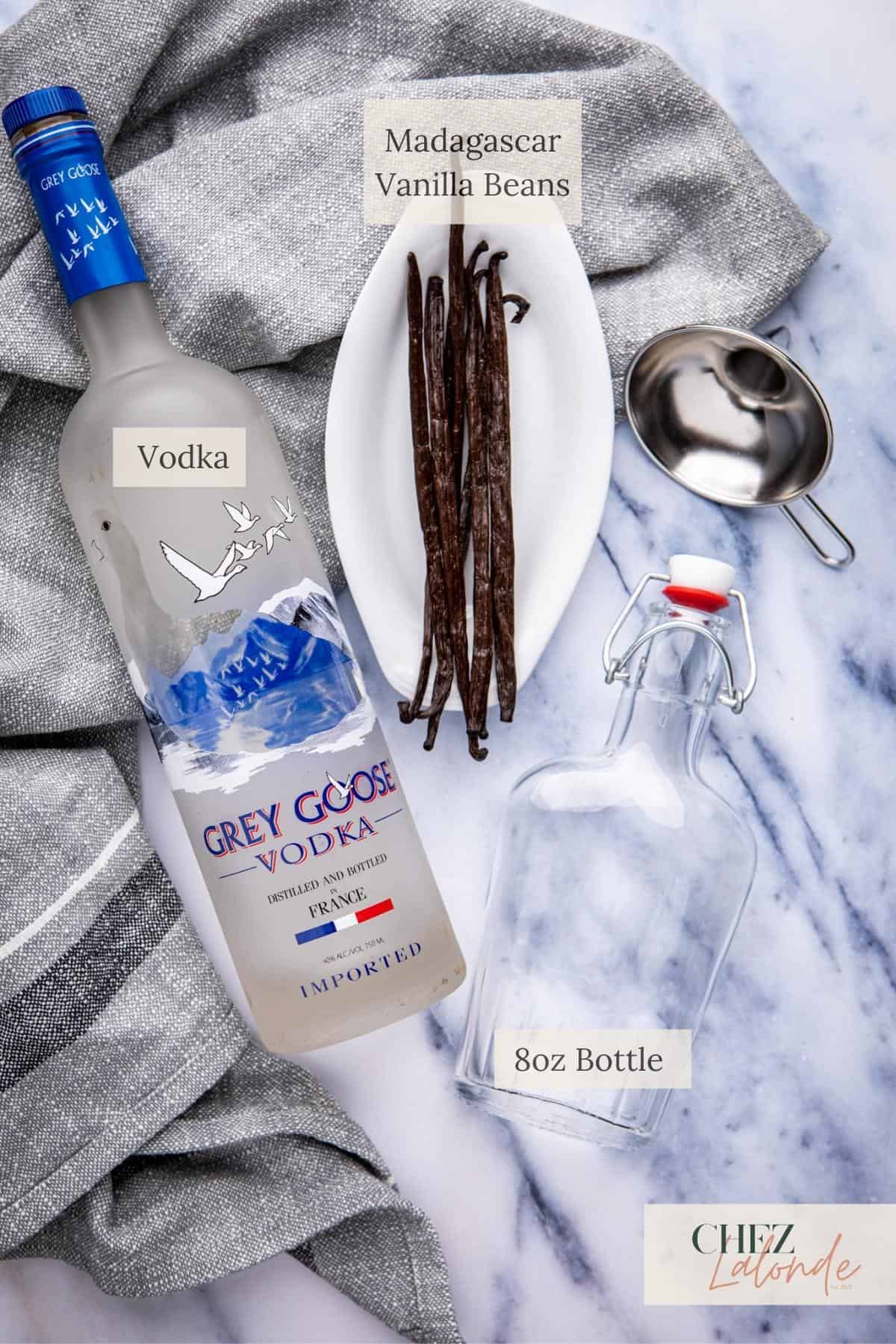
- Vanilla Bean – is the crucial ingredient for vanilla extract because they contain all the essential compounds that give vanilla its distinctive flavor and aroma. Within the beans are tiny seeds packed with natural vanillin, the primary flavor compound in vanilla. When the beans are infused with alcohol, these compounds are released, creating a concentrated and flavorful extract.
- Vodka – Vodka is the most common alcohol in homemade vanilla extract recipes. Vodka is the best alcohol to use as the base for homemade vanilla extract. It is a clean and versatile medium to extract the flavors from vanilla beans effectively while ensuring a long-lasting and high-quality end product.
Recipe Substitutions and Variations
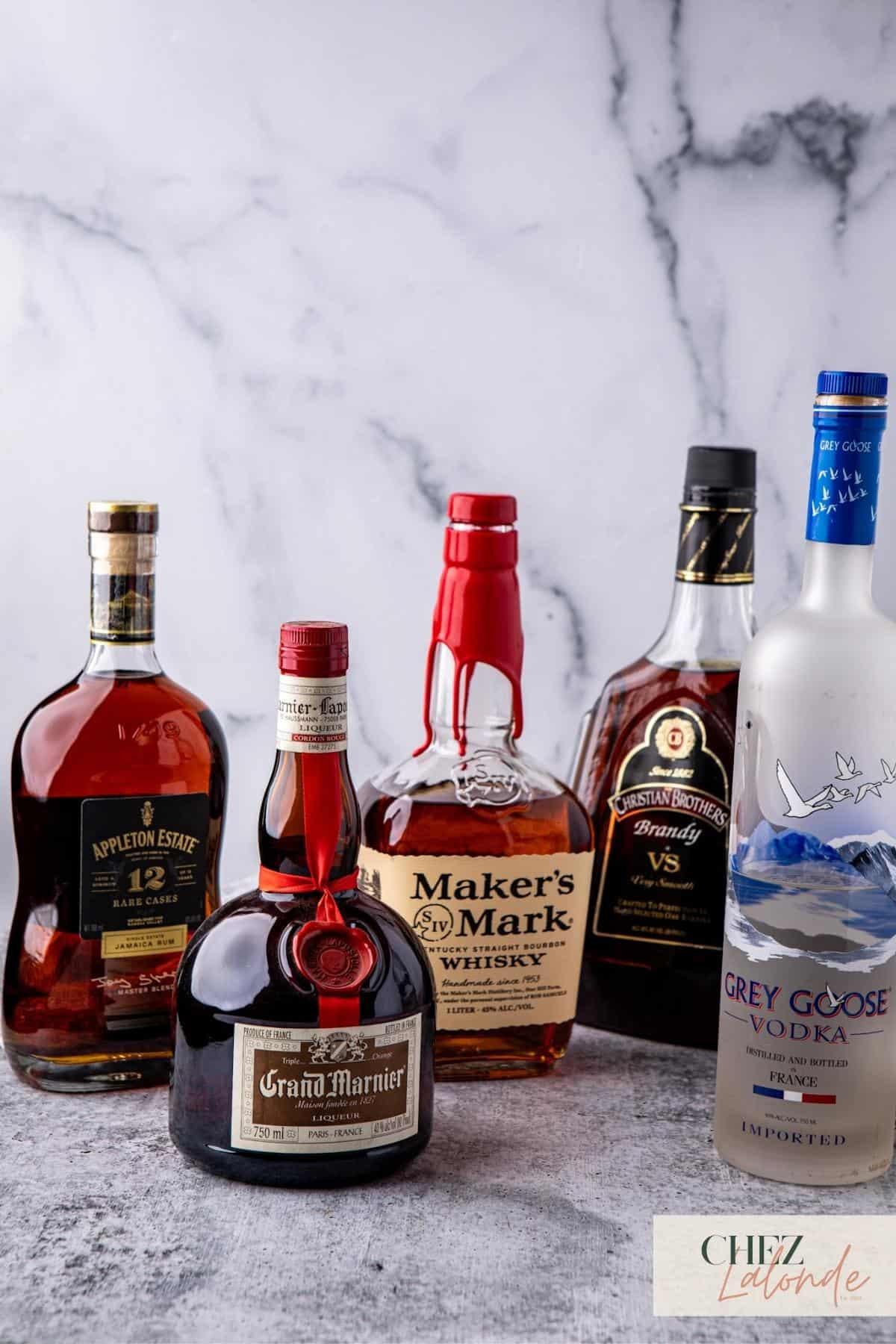
Try Different Alcohol Bases:
While vodka is commonly used, you can experiment with other alcohol options to impart unique flavors to your vanilla extract. Try using dark rum, bourbon, or brandy as substitutes for vodka. Each alcohol will bring distinct notes and complexity to the final vanilla extract.
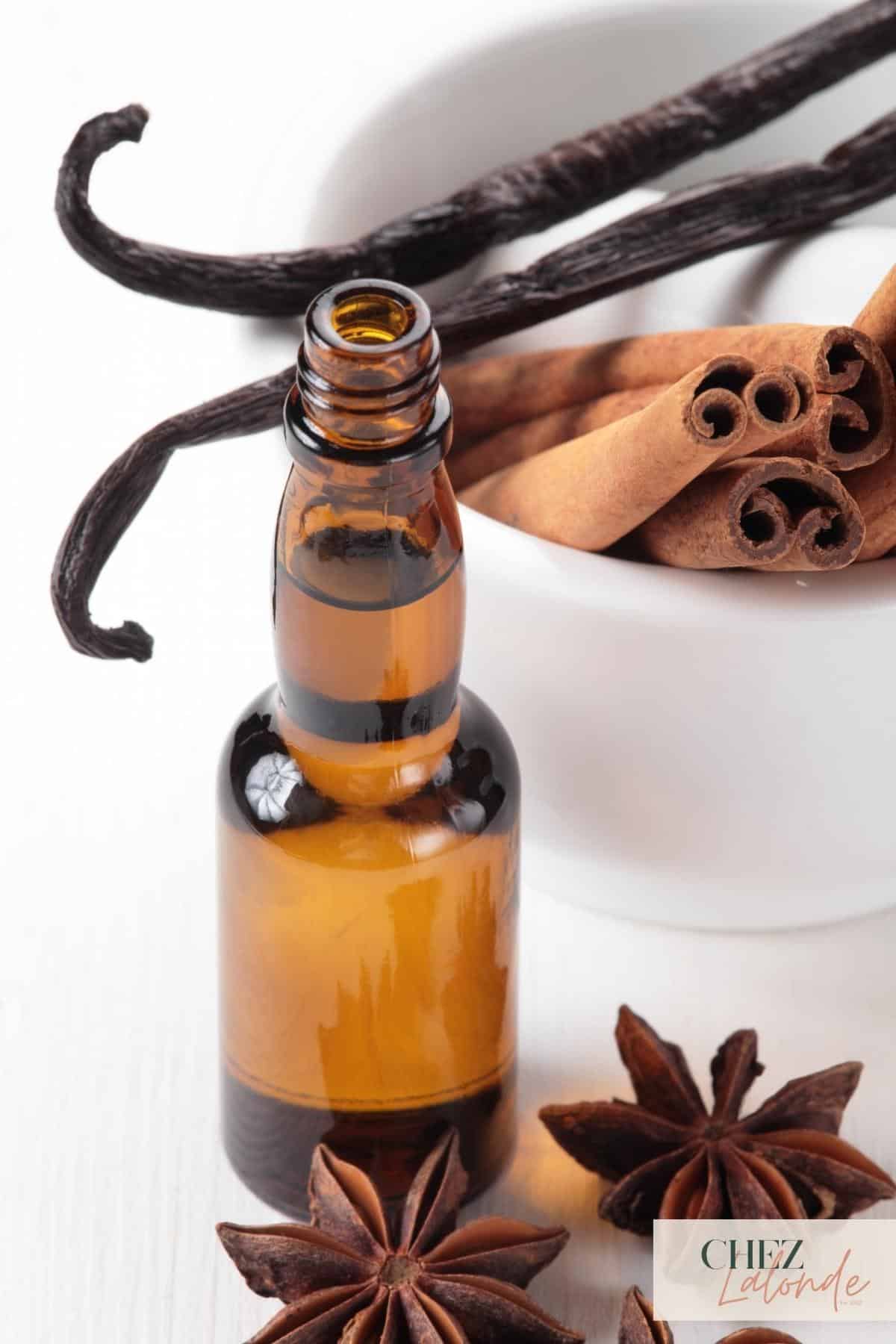
Try Different Spices:
Experiment with herbs and spices to create unique flavor combinations. Add ingredients like cinnamon sticks, cloves, star anise, cardamom pods, or nutmeg to infuse interesting aromatic notes into the extract. These spices can provide exciting variations to your homemade vanilla extract, making it even more versatile and flavorful in your culinary creations.
6 Easy Steps to make your spectacular gourmet extract
Step One: Before you begin this process, it is essential to sterilize your canning jars or bottles to ensure cleanliness and maintain food safety standards. Ensure you pat the bottle dry.
Step Two: Use a food scale and weigh 1 oz of vanilla beans. Then, use a sharp knife to make a gentle lengthwise slit in the vanilla beans, ensuring not to split vanilla beans in half. We only need a tiny opening to let the vanilla flavor seep into the alcohol.
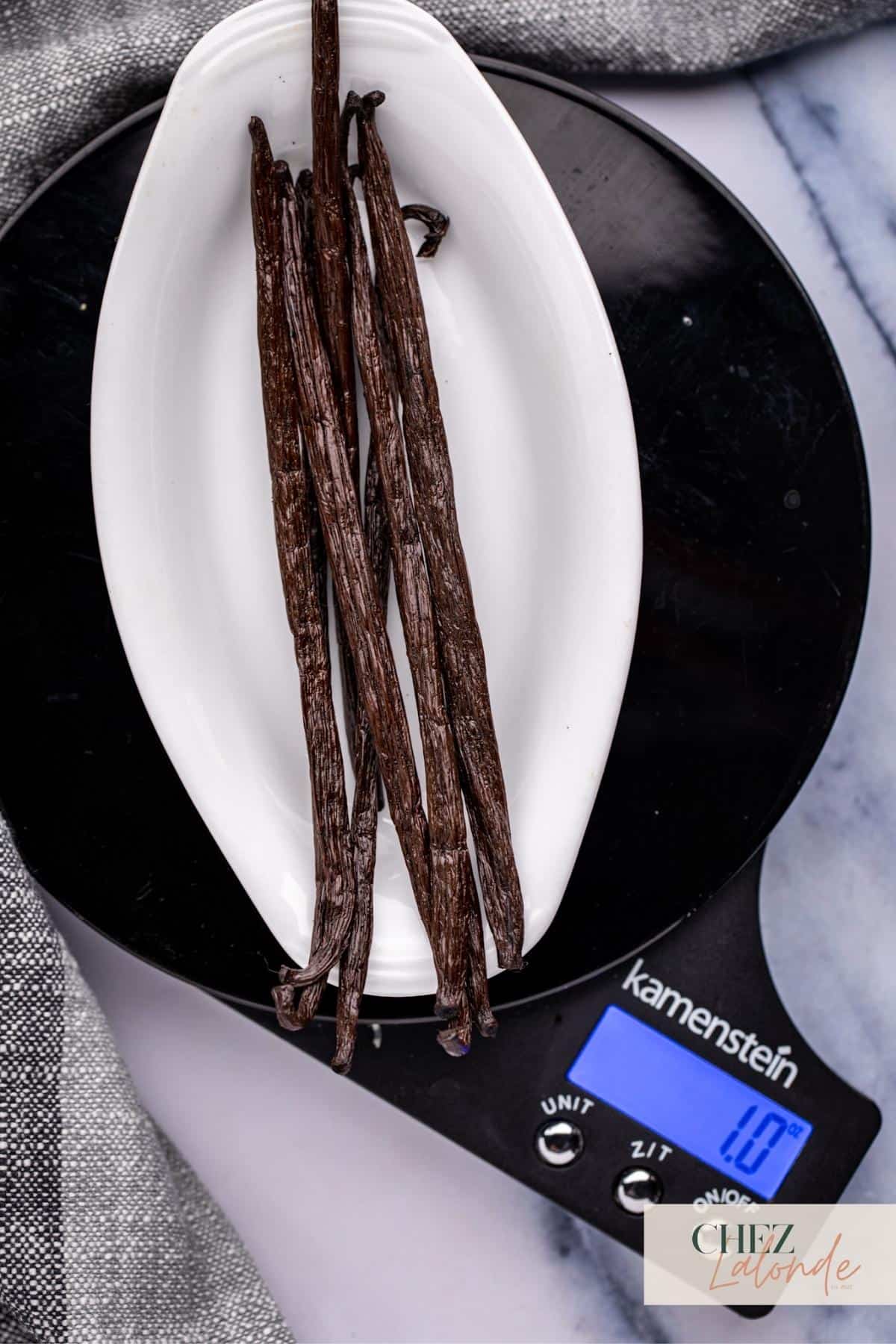
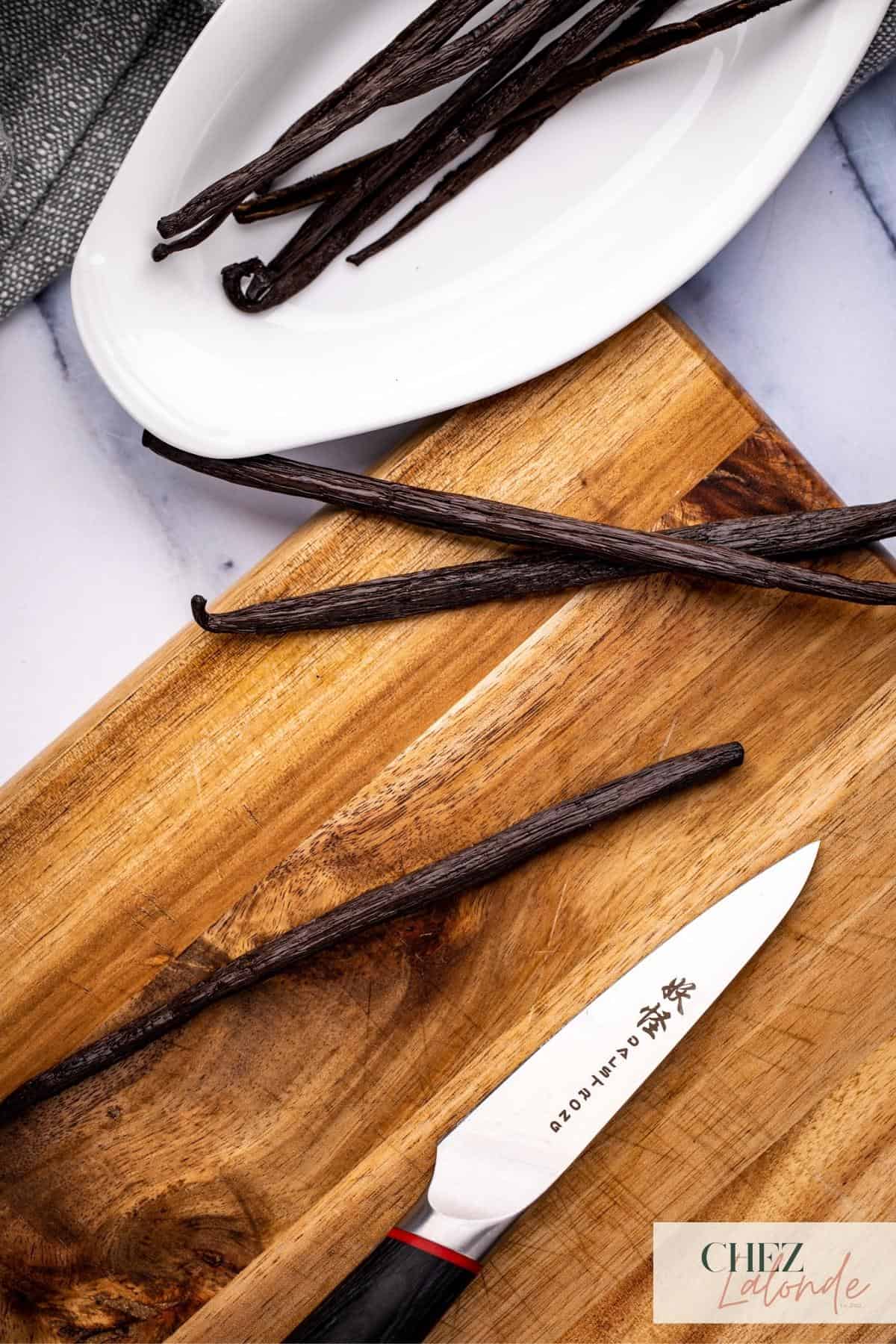

Step Three: Place 1 oz of vanilla beans into the bottle and pour in 8 oz of vodka (or your chosen alcohol), leaving some room at the top for heat expansion. Avoid filling the bottle to its brim to accommodate heat expansion during the Sous Vide process.

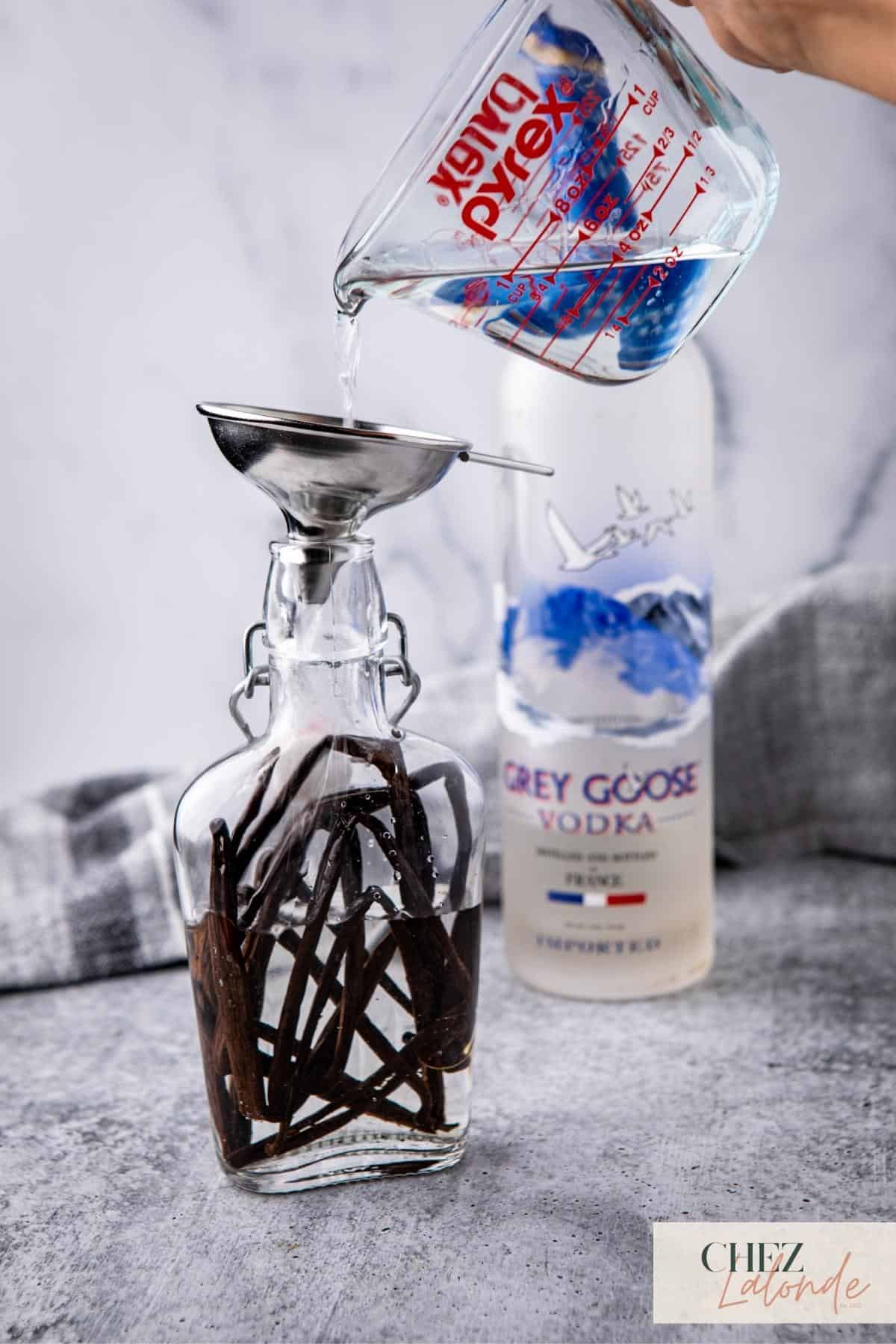
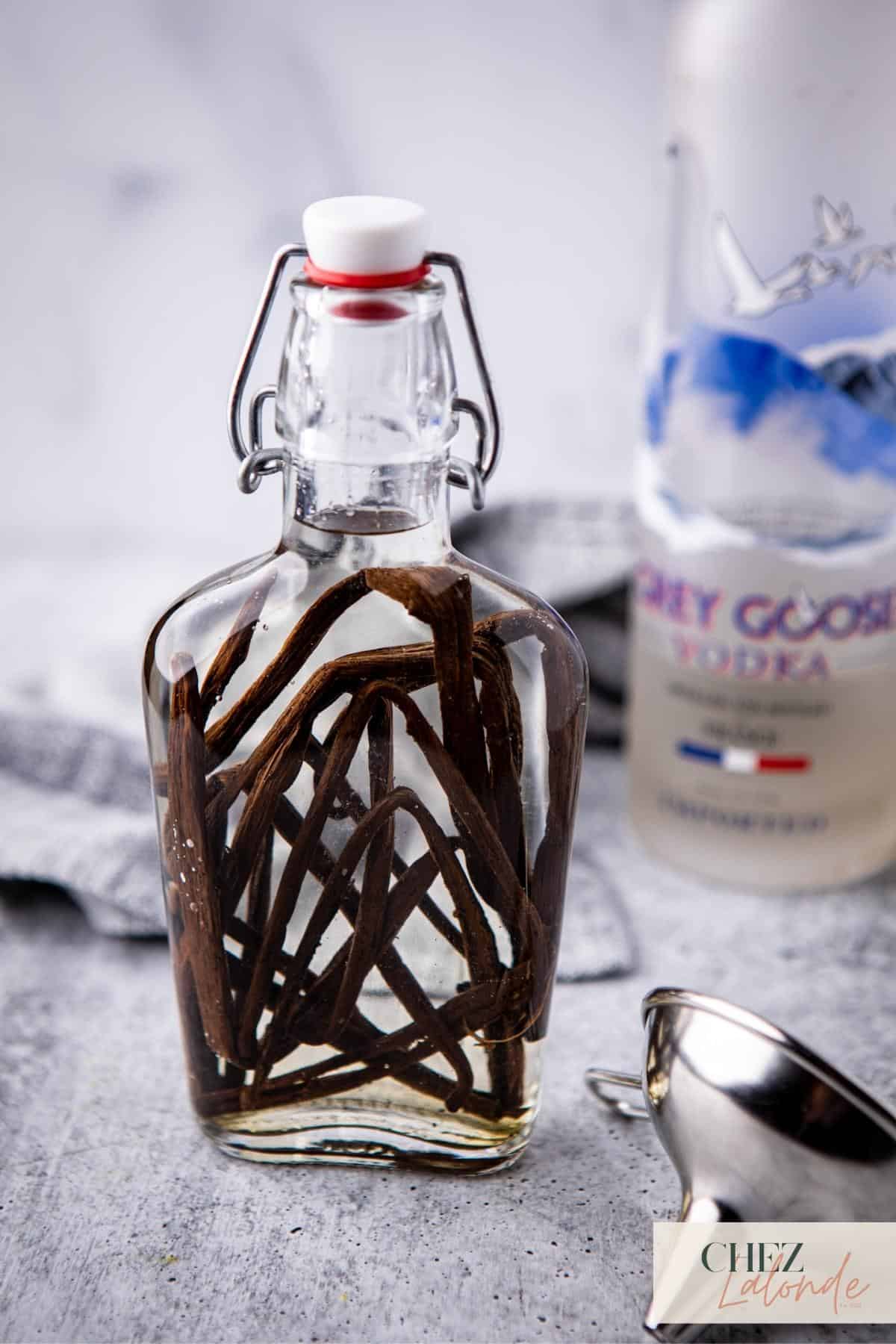
Pro Tip:
For a proper ratio, use 1 oz of vanilla beans for every 8 oz alcohol. If you’re planning a larger batch, measure your ingredients accordingly to maintain the desired flavor profile.
Step Four: Shake the bottle to ensure vanilla beans are fully immersed in Vodka. Fill a pot or Sous Vide container with room temperature water and place the Sous Vide precision machine inside. Place your bottles or jars into the pot before heating the Sous Vide bath. Switch on the Sous Vide machine and set the temperature to 135F/57C.
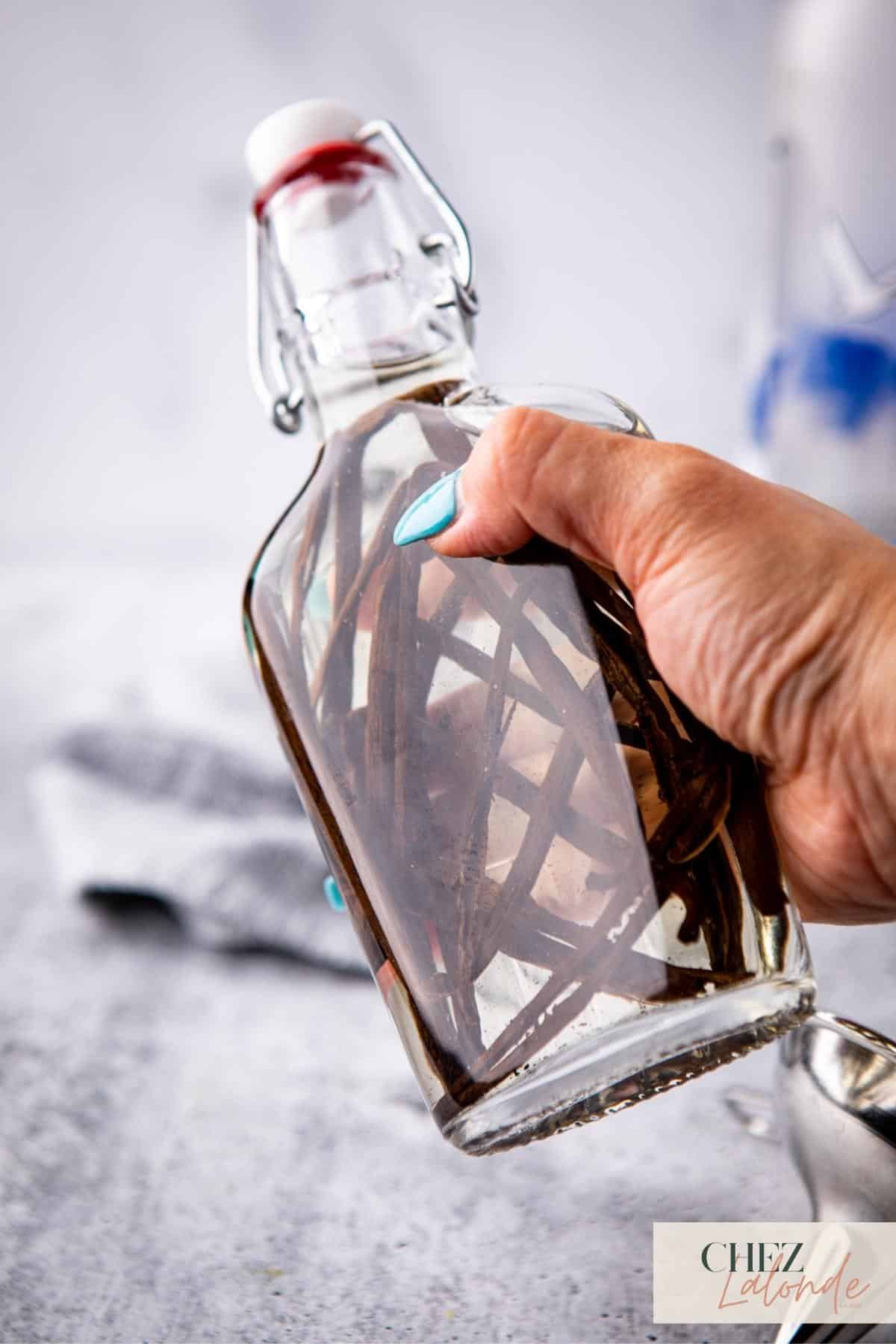

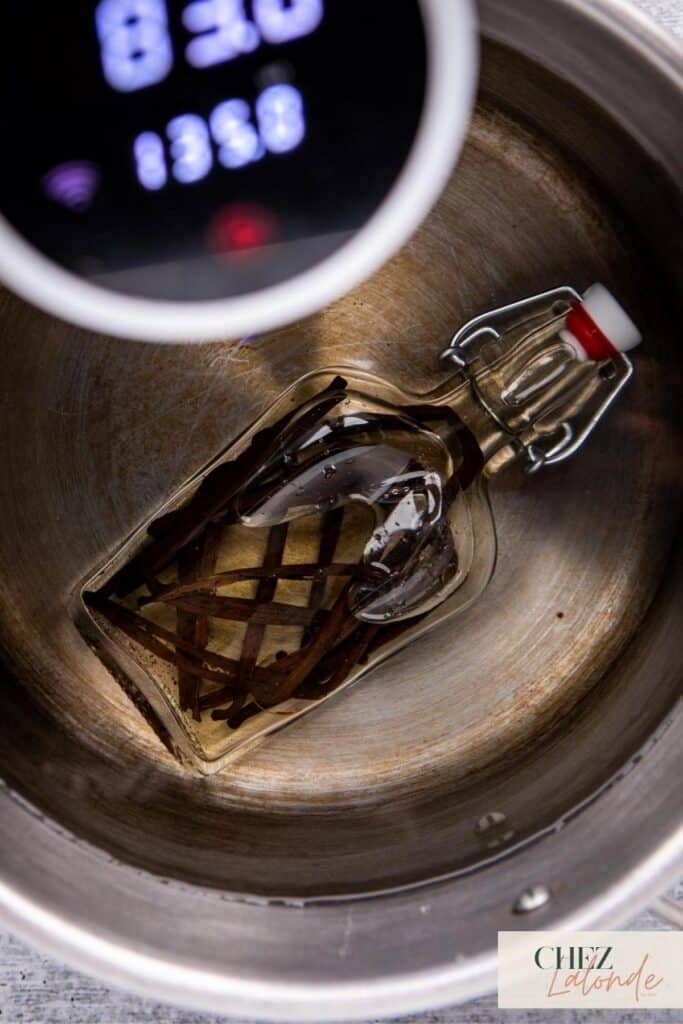
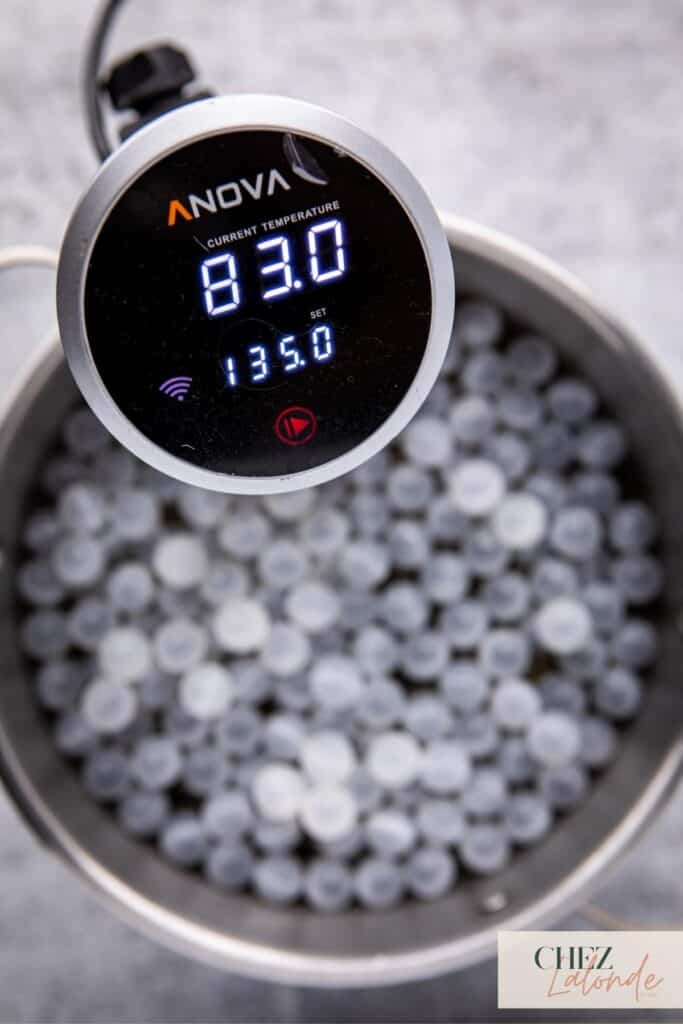
Step Five: When the water bath reaches the desired temperature, place sous vide insulating balls on top to retain the heat. Allow the vanilla extract to cook for 12 hours. For convenience, consider starting the cooking process before bedtime so the vanilla extract is ready when you wake up.
Step Six: After extraction, remove the bottles or jars from the water bath and allow them to cool to room temperature on the counter. Although not ready for immediate use, I suggest continuing the infusion process for another 3 months. Store the bottles in a dark place, away from sunlight and heat, and remember to shake them weekly to keep the vanilla beans fully submerged. This will enhance the flavor and aroma of the extract over time.

Recipe tips and tricks
- Sterilize your bottles or jars before each use: It’s crucial to sterilize them for cleanliness before each use. To do this, fill a pot with water and bring it to a rolling boil. Submerge the containers in the hot water for 5 to 10 minutes. Afterward, carefully remove them and pat them dry with clean paper towels. Now, your containers are sterilized and ready for your homemade vanilla extract.
- Gifting to friends: I used an 8 fl oz bottle in this recipe. For gifting, consider rebottling the extract into 2 oz Amber color bottles. Pair them with dry cookie ingredients in a Mason jar and package them in a gift box. It’s a thoughtful gift idea for Christmas or housewarming. By dividing the extract into smaller bottles, you can share your homemade goodies with up to 4 people, making it a more cost-effective and meaningful gift.
- The bean and Alcohol ratio is essential: To ensure a potent and flavorful vanilla extract, follow this simple ratio: for every 8 oz or 1 cup of vodka (or your preferred alcohol), use 1 oz of vanilla bean. Use a kitchen scale to accurately measure the beans, as their size and moisture content can vary. Typically, 1 oz of vanilla beans can range from 5 to 7 pieces. Avoid using an excessive or insufficient amount of beans, as it can result in either too strong or weak extract. Taking this step seriously will help you achieve the desired flavor profile in your homemade vanilla extract.
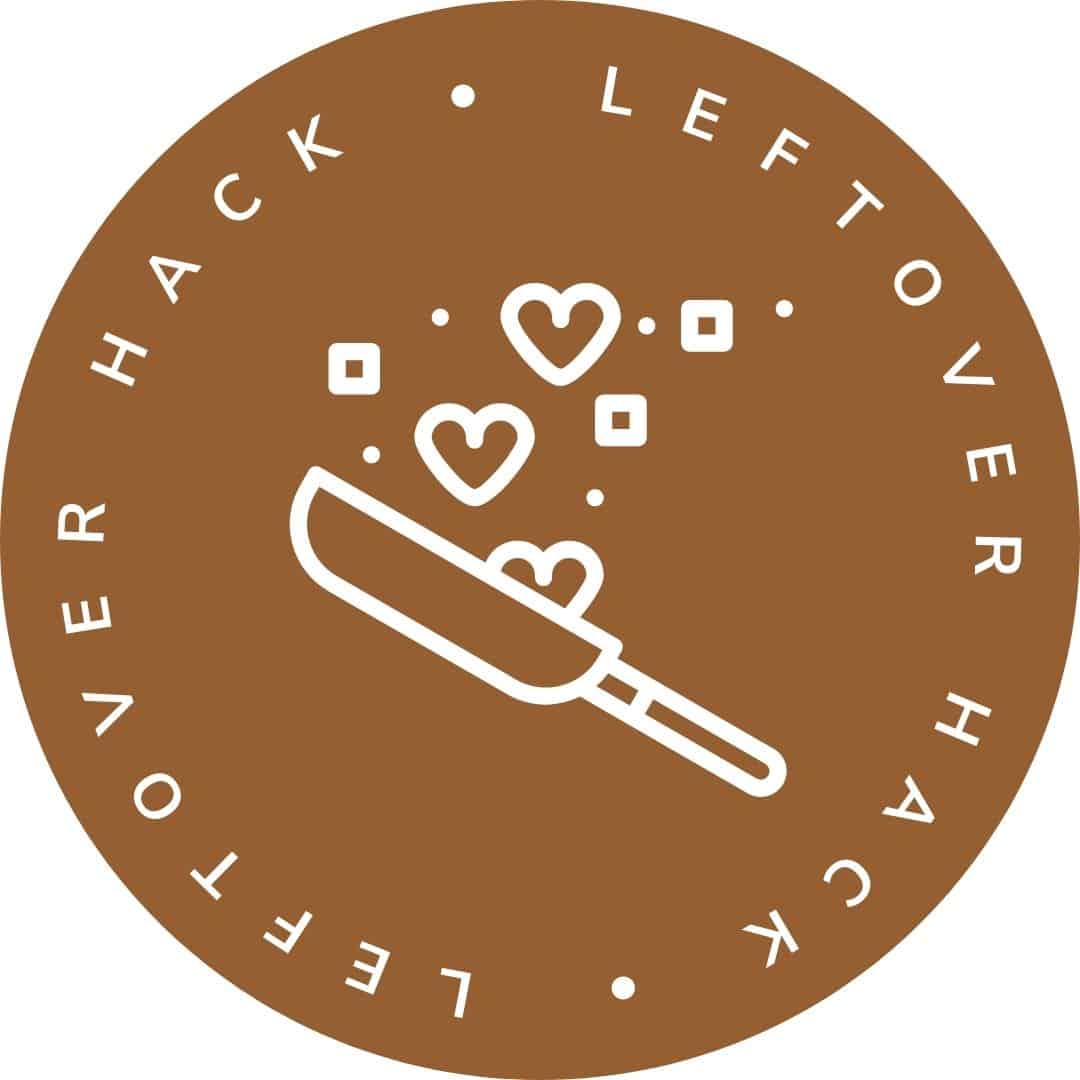
Storage Tips
Use small amber jars – Transfer your vanilla extract to an amber bottle after extraction. The amber color shields against UV light, preserving flavor and quality. Non-reactive and protective, it maintains extract integrity. Prevent flavor degradation from harmful UV light.
Store in a cool dark place: Always store your extract inside a cupboard or pantry. Keep it away from sunlight or heat sources. Sunlight and heat can degrade the flavor and affect its quality.
Label and Date: Don’t forget to label your containers with the date of preparation. This helps you keep track of the extract’s age and ensures you use it within its optimal shelf life.
Proper handling is vital: Research suggests that alcohol-based extracts have an indefinite shelf life. However, If the bottle is left open or exposed to moisture without appropriate care, it can compromise the vanilla extract and shorten its shelf life. Please follow my above instructions for optimal extract preservation and prolonged enjoyment.

FAQs about Sous Vide vanilla extract making:
You may like these other dessert recipes:
In Conclusion
Crafting your homemade Sous Vide vanilla extract offers a delightful combination of simplicity, quality, and versatility. This quick and easy method allows you to create a superior vanilla extract with a rich and authentic flavor profile. Not only does it save you money compared to store-bought options, but it also allows you to customize the ingredients and ensure the highest quality. So why wait? Start your culinary journey today and elevate your recipes with the magic of homemade Sous Vide vanilla extract.

Thank you for browsing. Follow my blog to stay in the loop and never miss a delicious post. Follow along for insightful tips, delicious recipes, and exciting experiments. Together, let’s unlock the secrets of gourmet flavors and create unforgettable culinary experiences.

Quick and Easy Homemade Sous Vide Vanilla Extract
- Total Time: 12 hours 15 minutes
- Yield: 8oz 1x
Description
Craft your gourmet sous vide vanilla extract with this easy recipe. Harness the power of precision temperature control to create a superior vanilla flavoring agent that bursting with authentic flavor. Elevate your culinary creations with the magic of homemade vanilla extract.
Ingredients
1 oz Vanilla Beans
8 oz Vodka
Instructions
Step One: Before you begin this process, it is essential to sterilize your jars or bottles to ensure cleanliness and maintain food safety standards. Ensure you pat the bottle dry.
Step Two: Use a food scale and weigh 1 oz of vanilla beans. Then, use a sharp knife to make a gentle lengthwise slit in the vanilla beans, ensuring not to split vanilla beans in half. We only need a tiny opening to let the vanilla flavor seep into the alcohol.
Step Three: Place 1 oz of vanilla beans into the bottle and pour in 8 oz of vodka (or your chosen alcohol), leaving some room at the top for heat expansion. Avoid filling the bottle to its brim to accommodate heat expansion during the Sous Vide process.
Step Four: Shake the bottle to ensure vanilla beans are fully immersed in Vodka. Fill a pot or Sous Vide container with room temperature water and place the Sous Vide precision machine inside. Place your bottles or jars into the pot before heating the water bath. Switch on the Sous Vide machine and set the temperature to 135F/57C.
Step Five: When the water bath reaches the desired temperature, place sous vide insulating balls on top to retain the heat. Allow the vanilla extract to cook for 12 hours. For convenience, consider starting the cooking process before bedtime so the vanilla extract is ready when you wake up.
Step Six: After extraction, remove the bottles or jars from the water bath and allow them to cool to room temperature on the counter. Although not ready for immediate use, I suggest continuing the infusion process for another 3 months. Store the bottles in a dark place, away from sunlight and heat, and remember to shake them weekly to keep the vanilla beans fully submerged. This will enhance the flavor and aroma of the extract over time.
Notes
For a proper ratio, use 1 oz of vanilla beans for every 8 oz of alcohol. If you’re planning a larger batch, measure your ingredients accordingly to maintain the desired flavor profile.
- Prep Time: 15 minutes
- Cook Time: 12 hours
- Category: Flavorings
- Method: Sous Vide
- Cuisine: French
Keywords: French cooking technique, Sous Vide, Mason Jar, Vanilla Bean, vanilla extract, baking, baked goods, cake, ice cream, cookies, pastries, vodka, bourbon, alcohol.
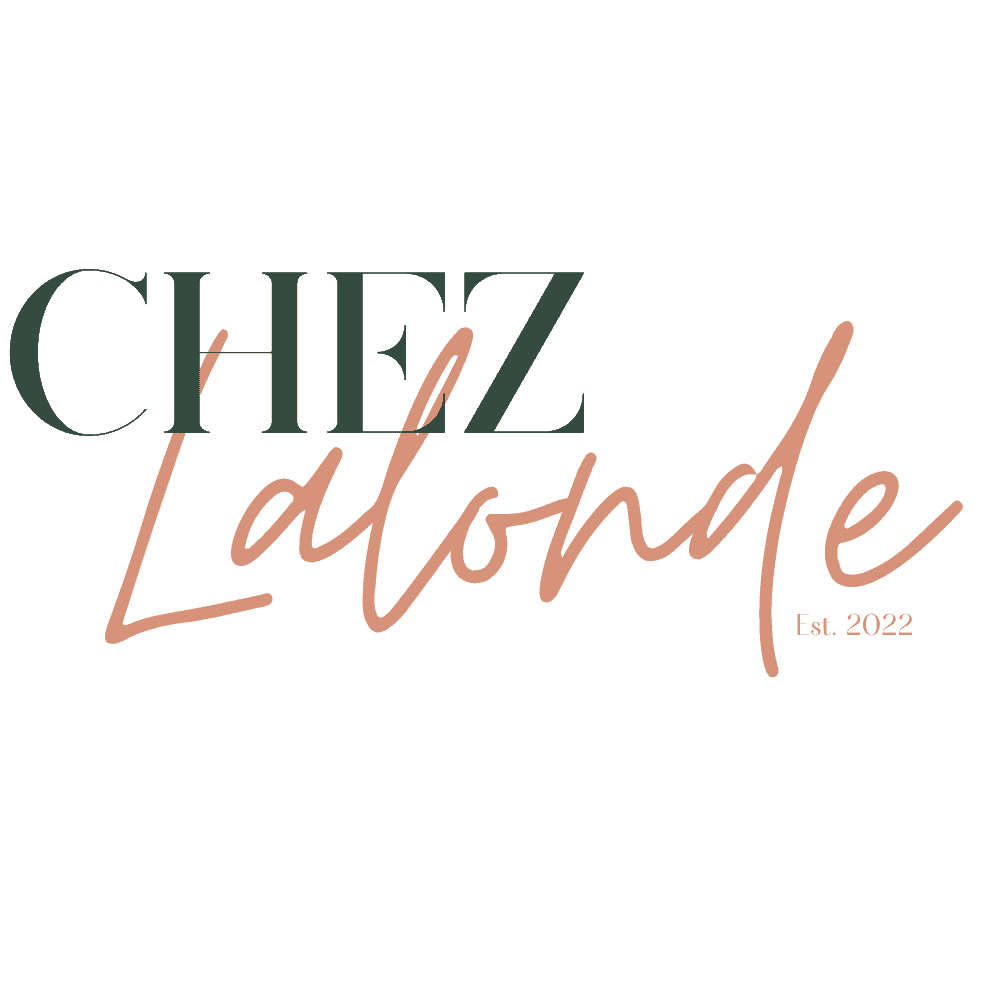
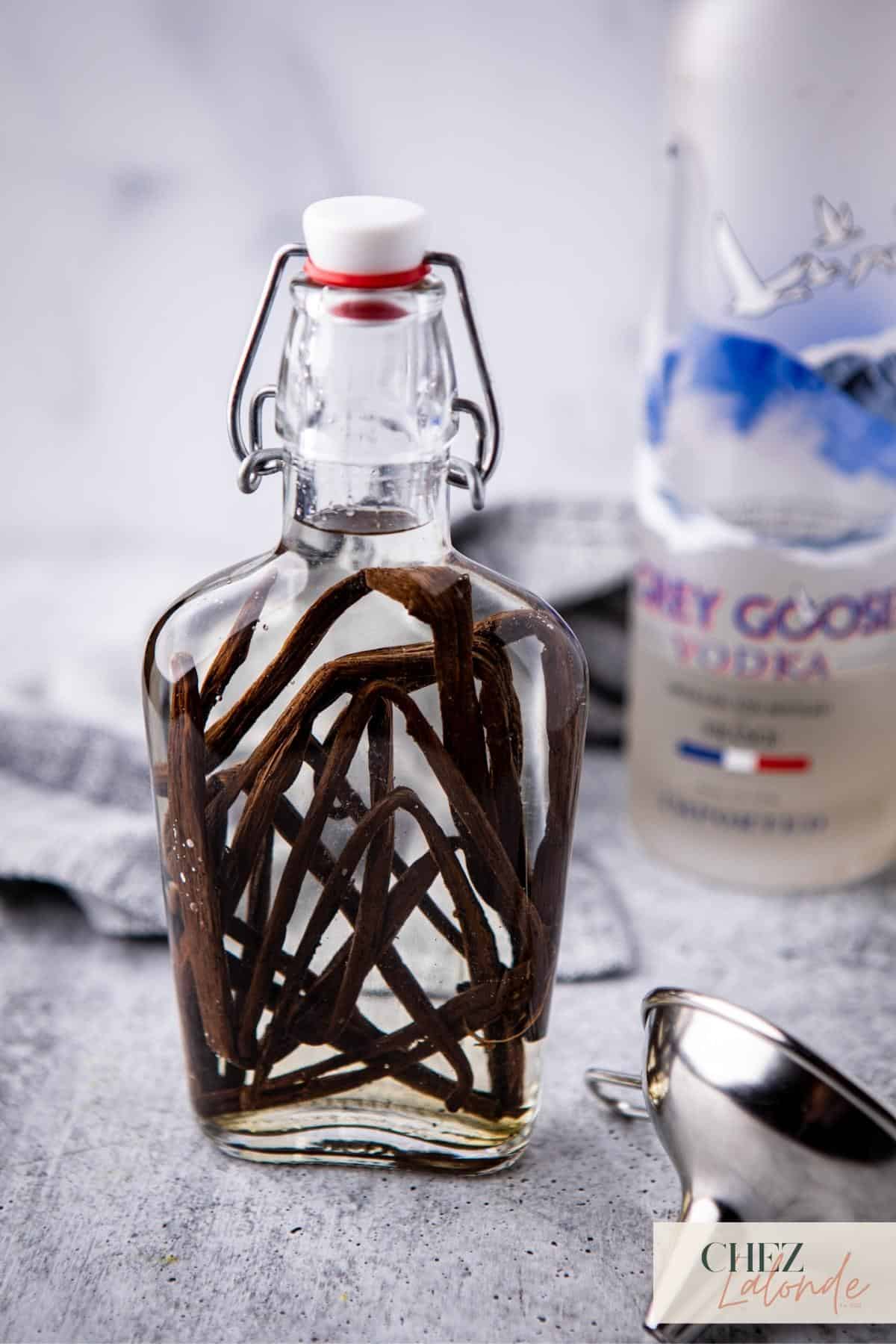
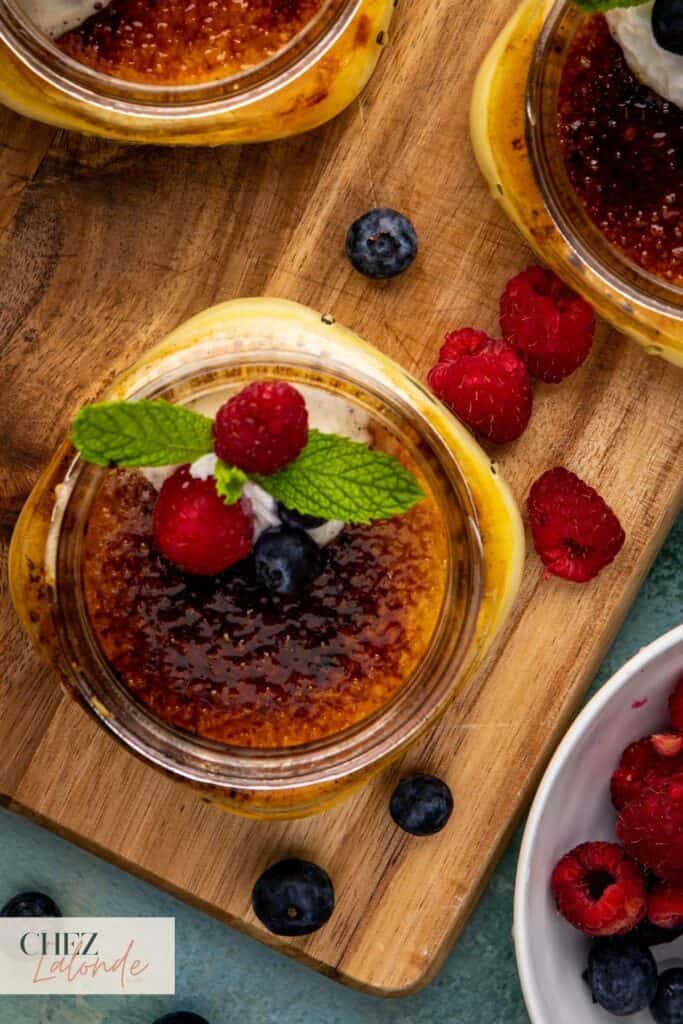
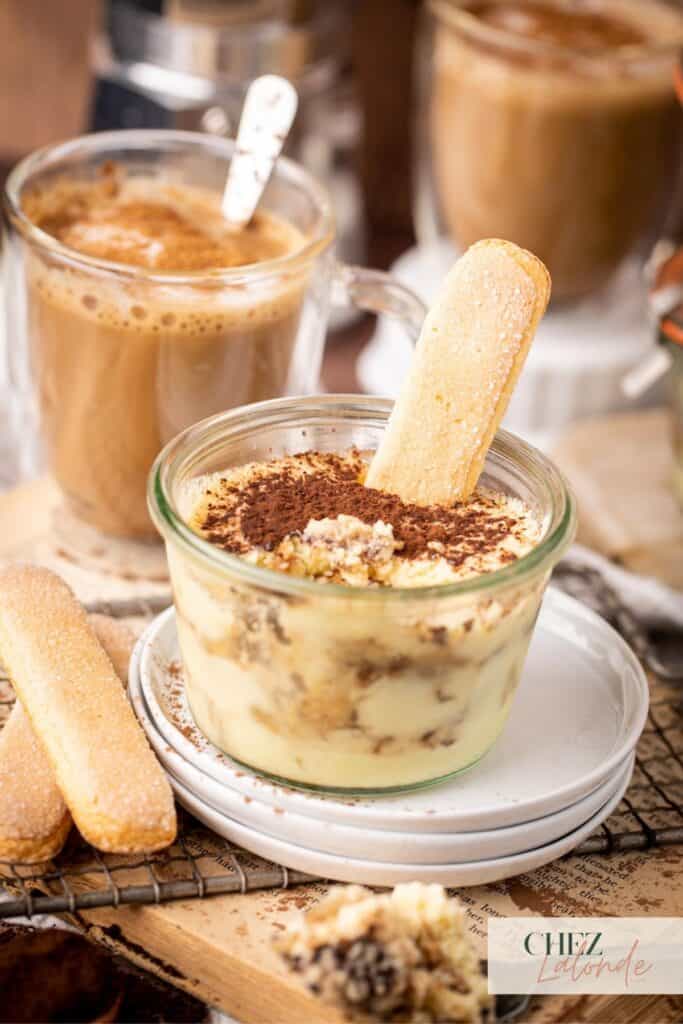
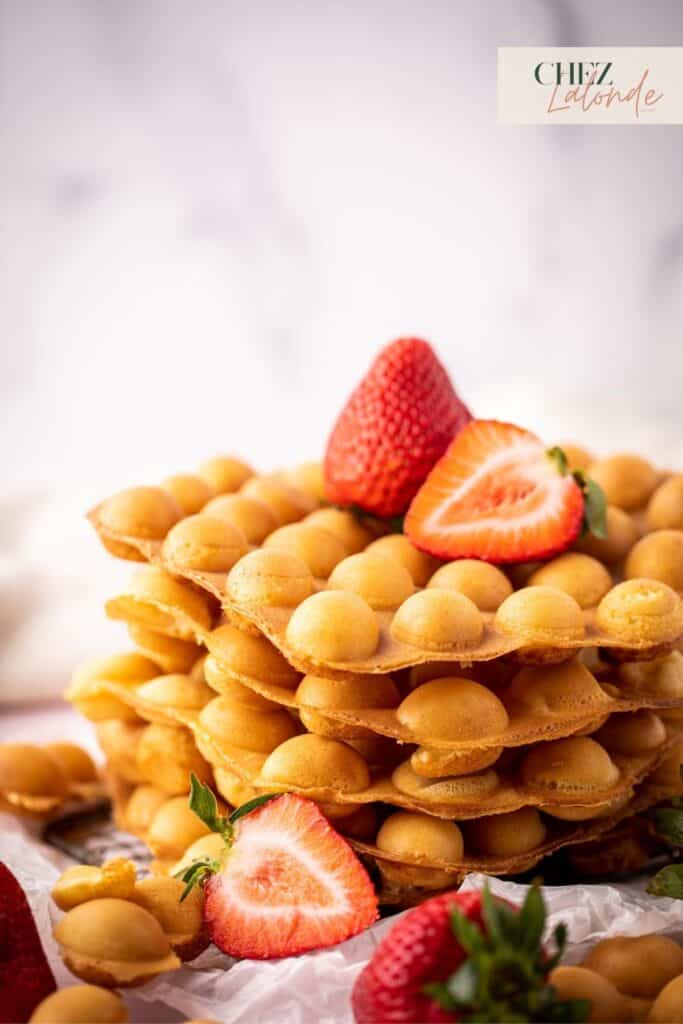


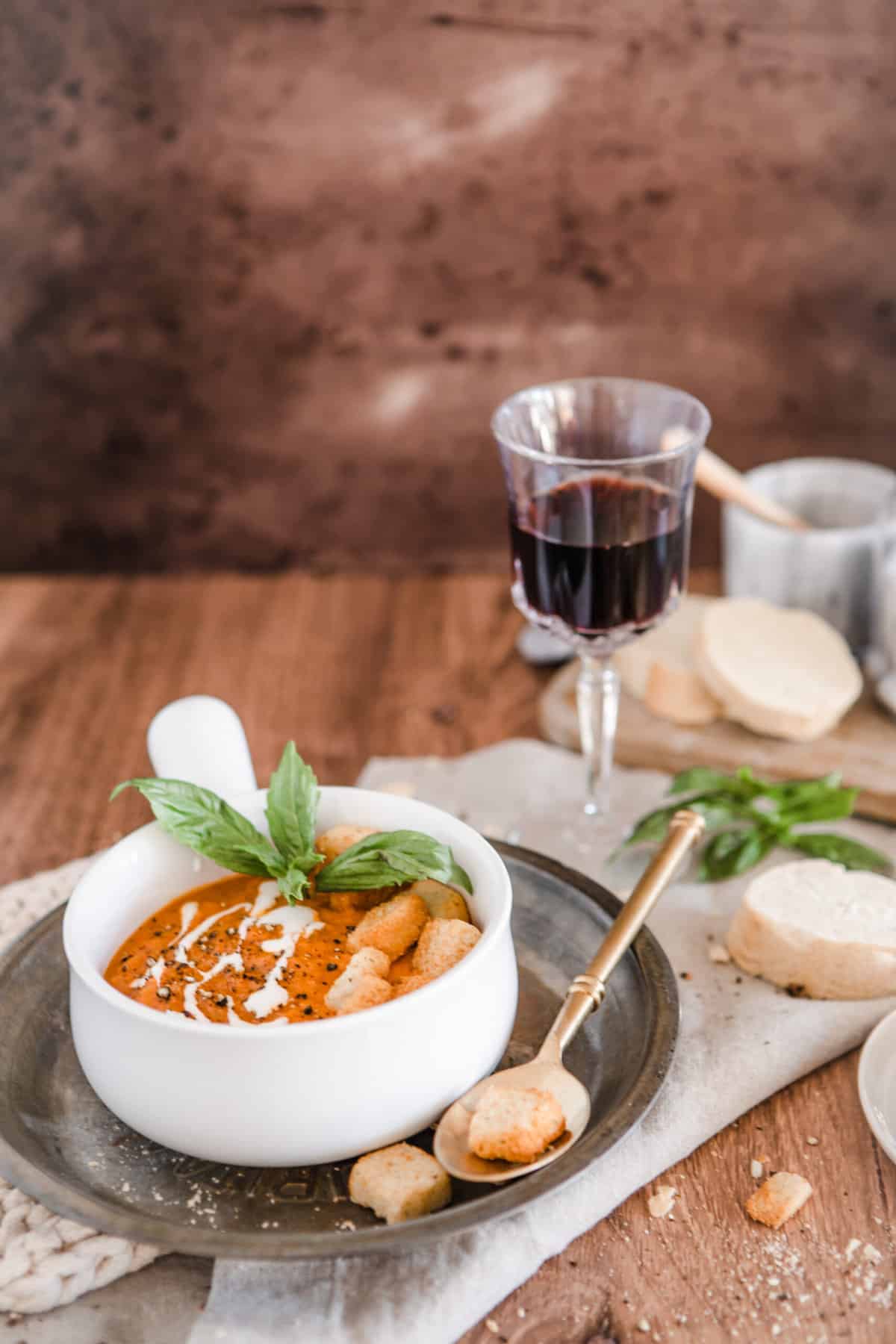
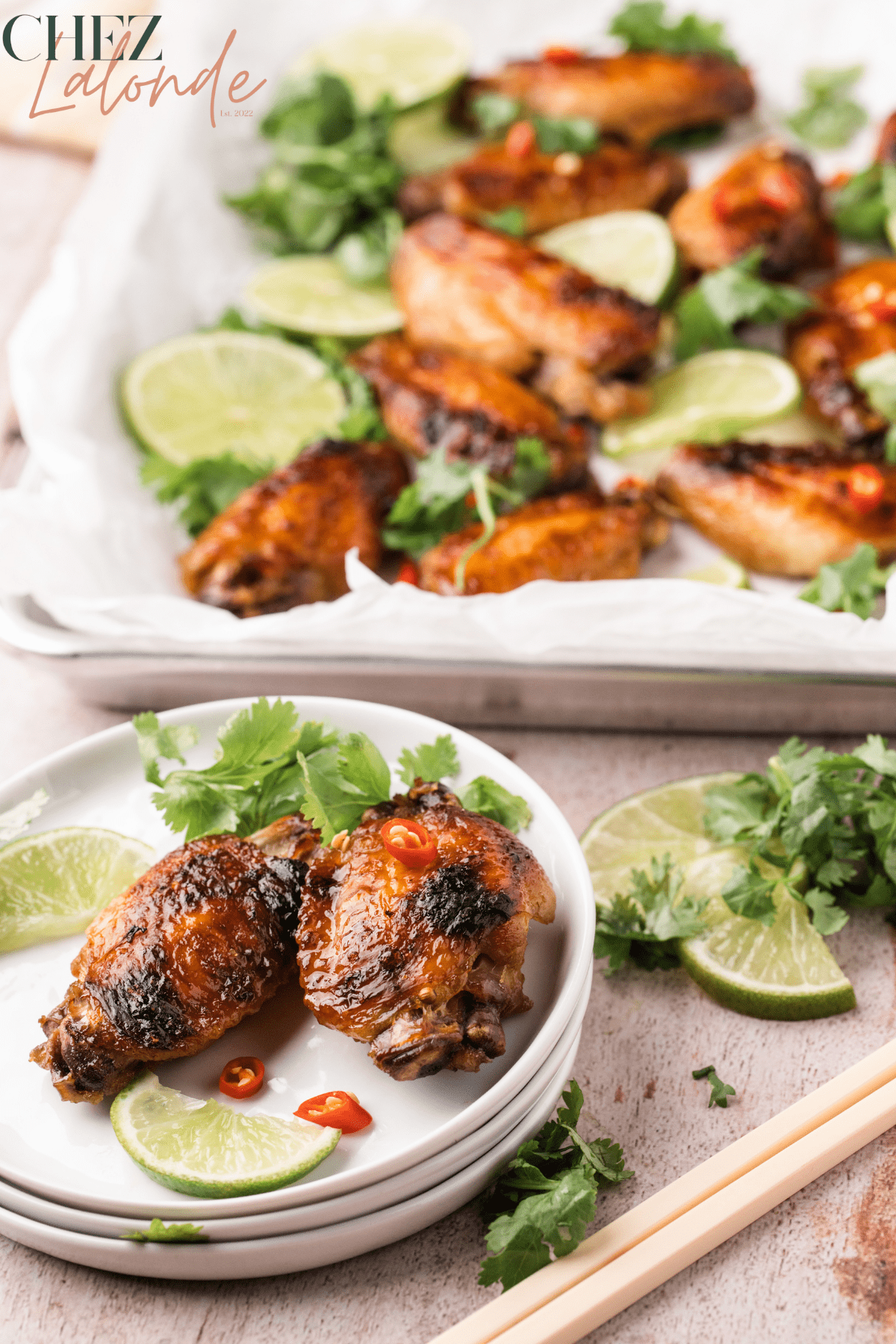
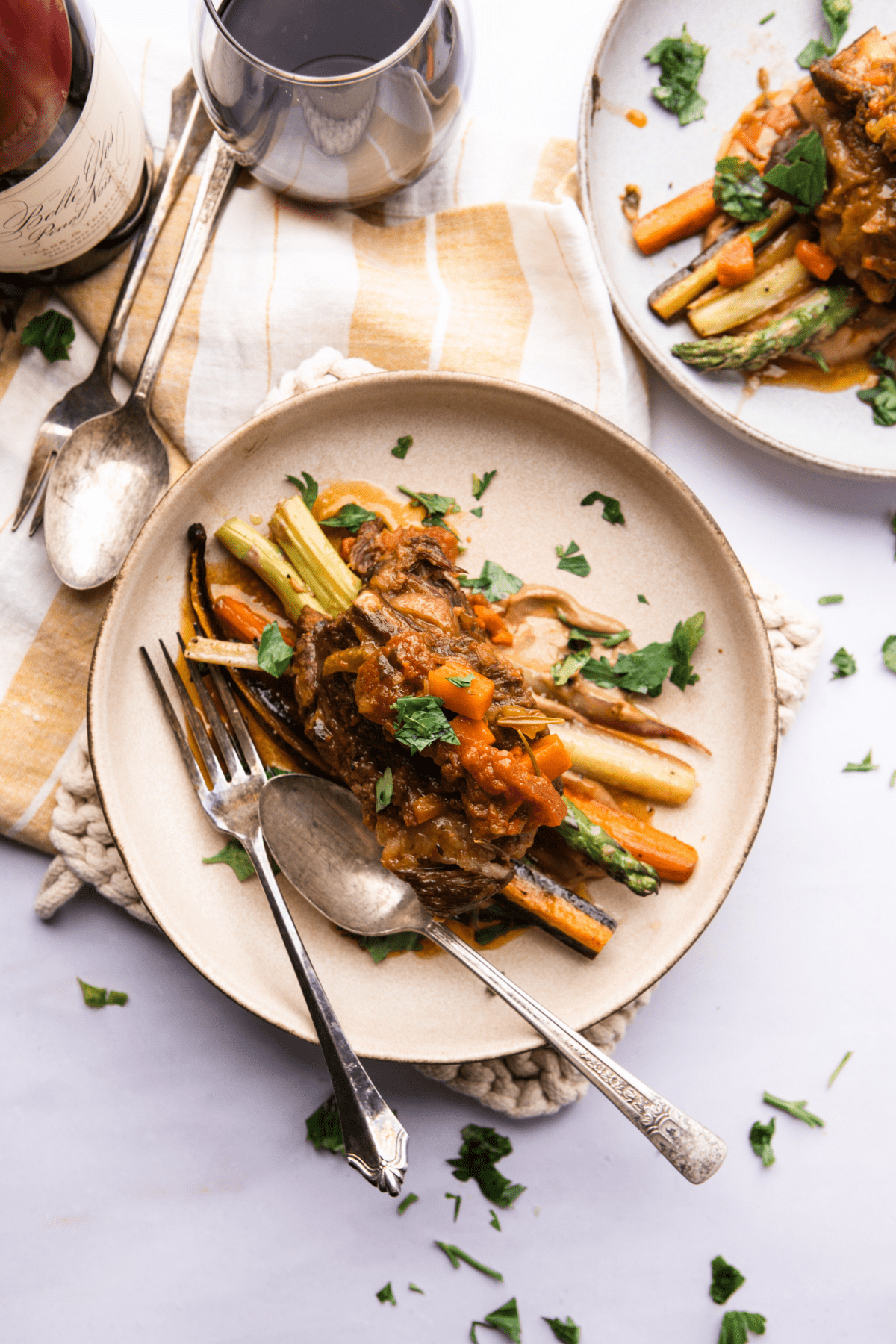
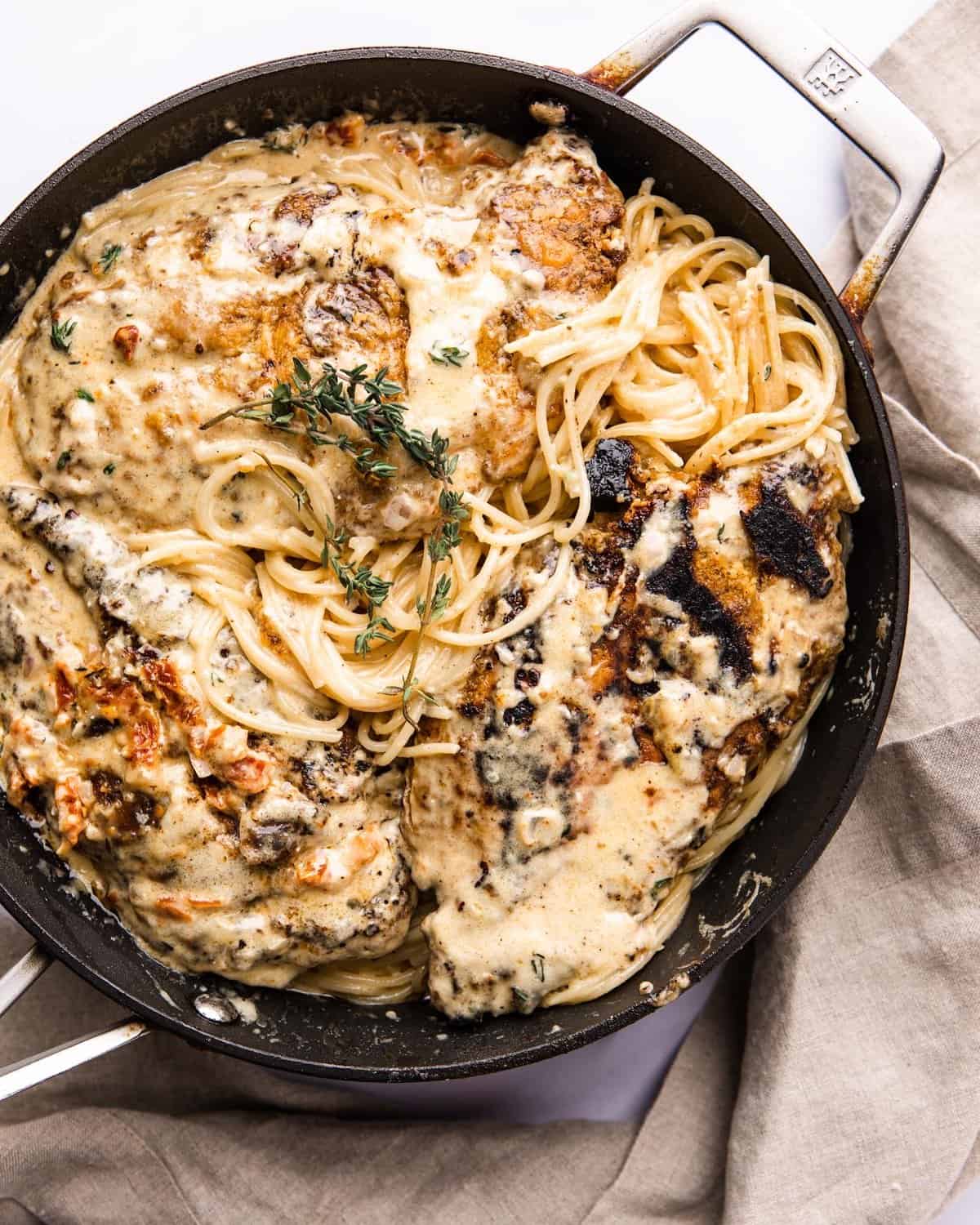



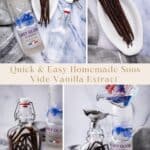




Once I’m done with the process do I leave the beans in the jar? Can I reuse them in another batch?
Thank you for reaching out with your question. Once you’ve completed the Sous Vide process, I highly recommend allowing the beans to steep in alcohol for an additional one to three months. Personally, I found the best results after a three-month steeping period, resulting in an amazing taste and aroma.
Avoid reusing the beans; instead, leave them in the jar and make sure to shake the bottle at least once a week.
If you plan to share this delightful concoction with friends and family, consider purchasing small 2 oz jars online or from the Container Store. Place 1 to 2 beans in each jar for an aesthetically pleasing presentation. This not only looks appealing but also allows others to continue steeping the beans in alcohol for a stronger flavor.
I hope this information proves helpful. If you have any further questions or need additional assistance, please feel free to let me know. Wishing you a joyous holiday season!